Summary
Click on the pictures to enlarge them and click on the tabs for more information and recommendations.
London is a cosmopolitan and commercial metropolis brimming with history and stunning architecture. Home to Big Ben, Buckingham Palace, and other monumentally captivating attractions, this city never fails to entertain and amaze.
London—the capital and largest city in the United Kingdom—is one of the most important global cities, exerting tremendous influence on the world stage in areas such as commerce, the arts, education, finance, and tourism, among others. And even though London is one of the most expensive cities in the world, the wonderful attractions here (many of them world-renowned) are well worth the visit.
The weather can be slightly gloomy and unpredictable (people habitually carry umbrellas because the rain is so random), but London is still very lively and vibrant as a whole.
Overall, London is one of my favorite cities in the world. I have many friends in this part of the world, and there are always so many things to do and so much fun to be had.
When you visit, make sure to follow this London Adventure Guide to maximize your time here.
Recommended Duration of Visit
4 days (ideal), 3 days (doable), 2 days (difficult)
Click for some interesting facts about London
Flights / Getting There: Ideally, you will fly into major airports like London Gatwick or London Heathrow.
At the airport, there will be trains departing for London. Simply purchase a ticket (from a kiosk or attendant) and take the designated train. You can also take the bus. Some buses use wireless credit cards, so you basically tap to get on and then tap again before getting off.
If you are willing to pay more, Victoria Station has an express train to/from London Gatwick, and Paddington Station has an express train to/from London Heathrow. For example, the Heathrow Express took me to/from the airport in about 15 minutes. As a reference, cab rides are far more expensive and about 3 times slower.
Climate: London has an oceanic climate with mild summers and cool (but not too cold) winters. The city has rain about a third of the year, and overcast skies are a common occurrence. However, weather patterns can be quite unpredictable. This is why you will often see the locals carry umbrellas regularly. Or maybe it is a Mary Poppins thing. Who knows.
Communication: English is the official language (shocker, I know).
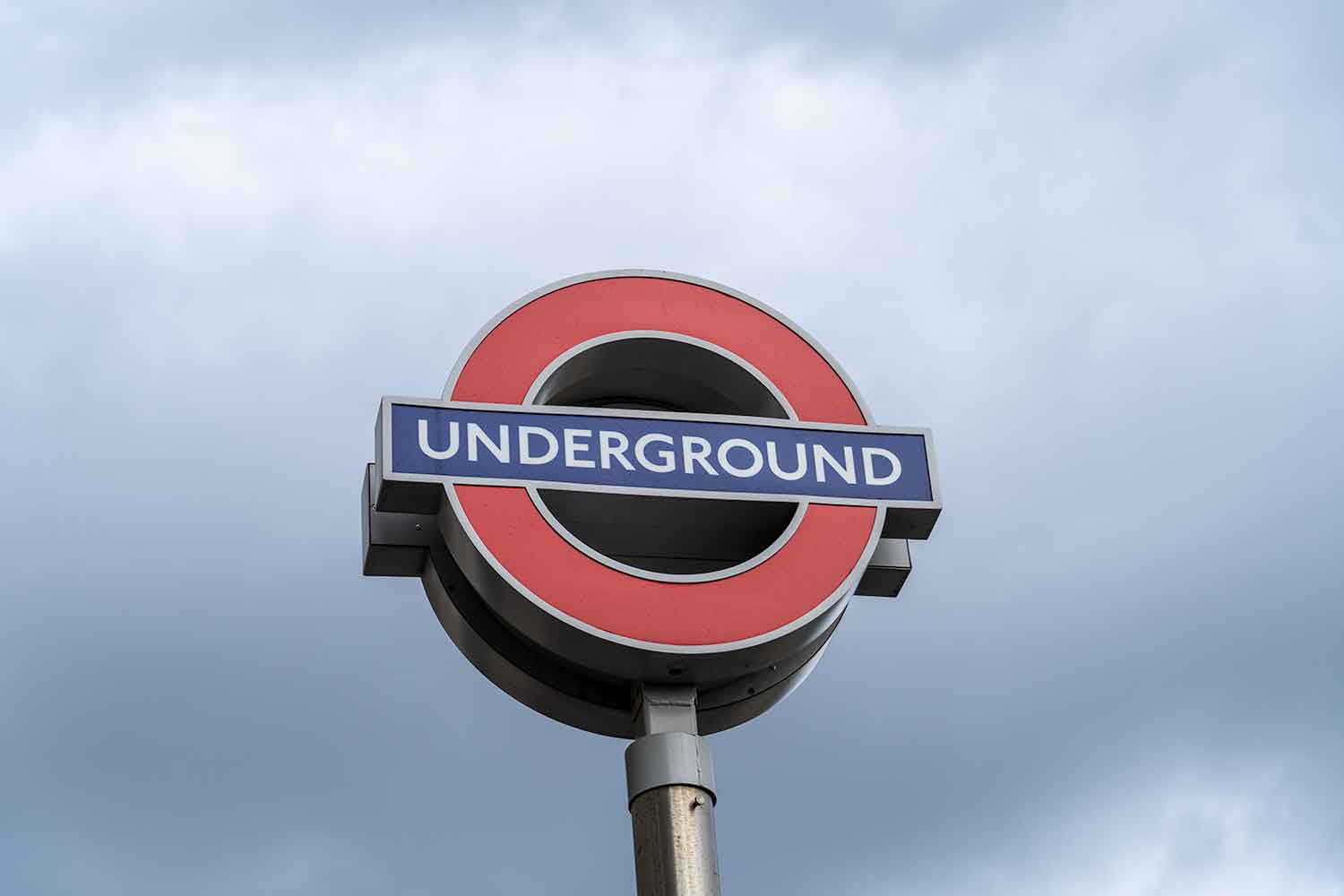 Navigation: Entrance to the London Underground is indicated by a sign with a red circle that says “underground.”
Navigation: Entrance to the London Underground is indicated by a sign with a red circle that says “underground.”
If you wish to use London’s transportation system, then an Oyster Card can be used for the London Underground (the “Tube”), London Overground, London Buses, etc. You can buy the Oyster Card at London Heathrow and at most kiosks.
If you are planning to use public transportation extensively on certain days, then get the day pass. They are more efficient, less expensive (if you ride many times), and noncommital.
As a reference, the Piccadilly line is en route to most major attractions.
Google Maps is very helpful for navigating the London Underground because it tells you which station to enter and exit. It would also be very helpful to download an offline map.
Lodging: London is notoriously expensive. Ideally, you will stay in hostels or Airbnb’s to reduce costs. I stayed at SoHostel—a hostel centralized in the festive Soho region.
Activities Planning: The London Pass offers discounted packaged deals for numerous attractions (i.e. The Tower of London, St Paul’s Cathedral, and the Tower Bridge, among others).
The London Explorer Pass also offers discounted packaged deals for numerous attractions. Some of the attractions are not covered in the London Pass (like the London Eye).
Of course, there is no need to purchase both passes. Simply pick the pass that includes most of your desired attractions. Please refer to the attractions section for more information on some of the best attractions in London. I include websites where you can look up costs for various attractions.
As mentioned previously, the Oyster Card is very helpful if you plan to use public transportation.
Special Considerations
General: Student ID’s will help reduce costs at numerous attractions. I also recommend having an umbrella ready just in case (you can buy them almost anywhere).
Peak Seasons: Late Spring (May) and Summer (June to September) are the peak seasons.
Currency: British Pound (GBP). Currency Converter.
With the exception of St. Paul’s Cathedral and the museums, the other attractions are paired up based on similarity and/or proximity. For example, The Tower of London and the Tower Bridge are near each other.
Most of the phenomenal museums in London are free to visit, but donations are appreciated. Additionally, most museums are open later on Fridays.
St. Paul’s Cathedral’s observation deck offers the most complete view of London’s skyline. The London Eye provides a more centralized view since it is pretty much toward the city center.
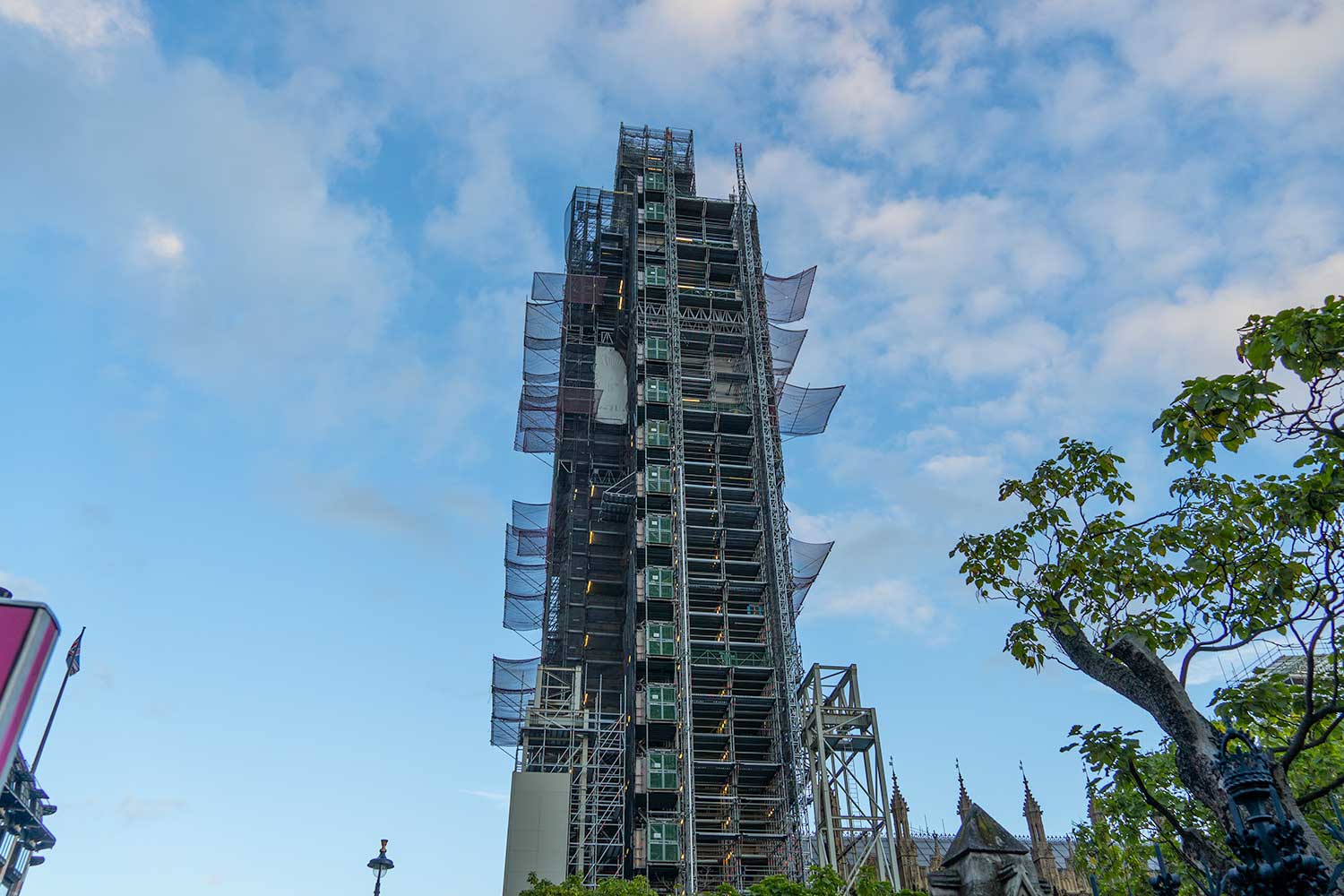 Big Ben (Elizabeth Tower): Big Ben is a cultural icon recognized all over the world. Interestingly enough, Big Ben is actually the name of the Great Bell in the Elizabeth Tower. It is also the largest of the towers five bells. The Gothic Revival tower—one of the most prominent symbols of the United Kingdon—stands at 315 feet (96 meters) tall.
Big Ben (Elizabeth Tower): Big Ben is a cultural icon recognized all over the world. Interestingly enough, Big Ben is actually the name of the Great Bell in the Elizabeth Tower. It is also the largest of the towers five bells. The Gothic Revival tower—one of the most prominent symbols of the United Kingdon—stands at 315 feet (96 meters) tall.
Cost: Free to visit. Recommended Duration of Visit: 10 – 20 minutes.
| To be fair, most people will never get to see it like this, so it’s actually quite a rare site to see (crappy, but rare). |
| Little Ben stands at the interesection of Vauxhall Bridge Road and Victoria Street in Westminster. |
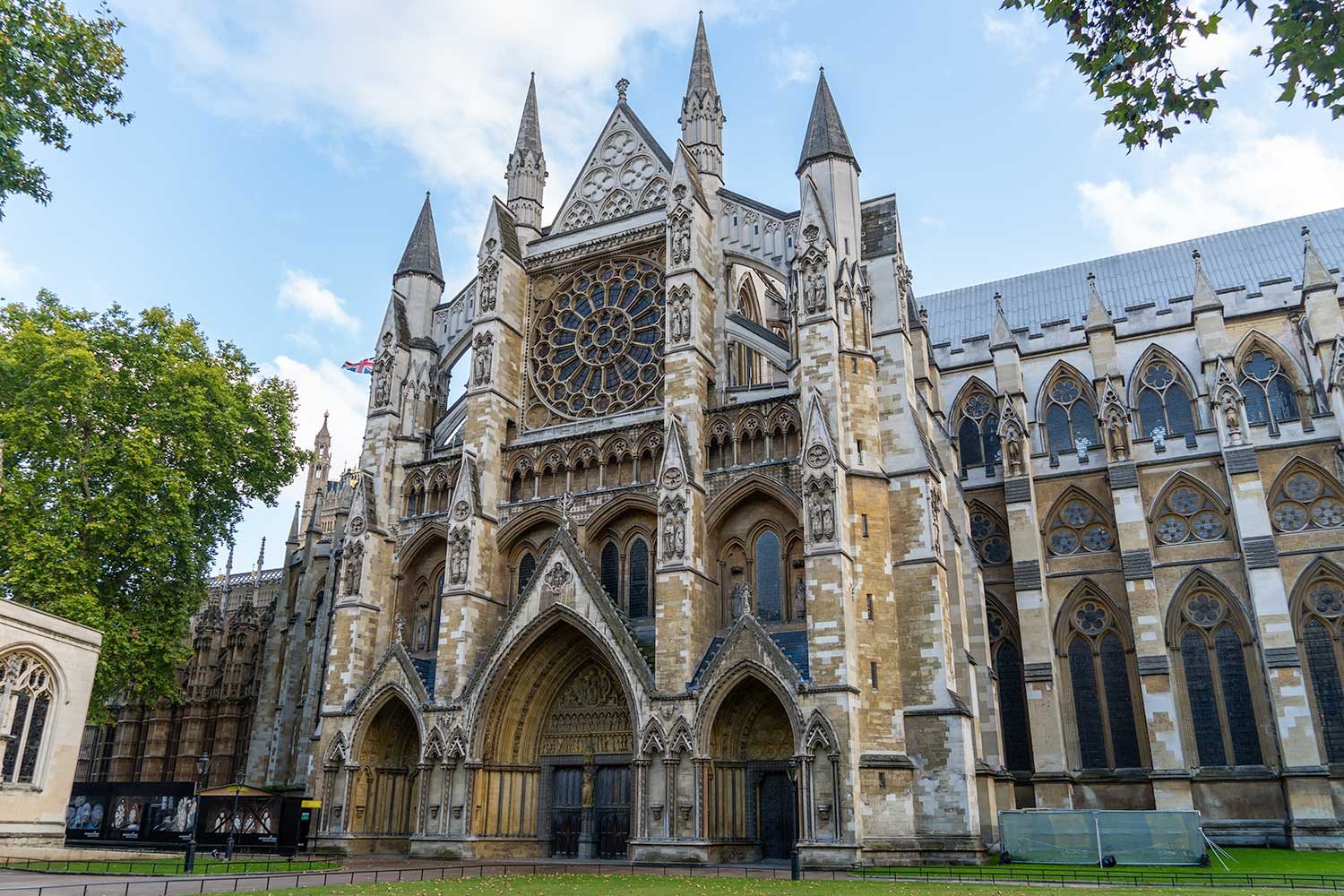 Westminster Abbey: This Gothic church, founded in 960 AD and formally known as the Collegiate Church of Saint Peter at Westminster, lies in the City of Westminster (a borough within London).
Westminster Abbey: This Gothic church, founded in 960 AD and formally known as the Collegiate Church of Saint Peter at Westminster, lies in the City of Westminster (a borough within London).
As one of the United Kingdom’s most widely-recognized buildings, Westminster Abbey is a World Heritage Site, the final resting place of over a dozen monarchs, and a very popular must-see tourist attraction. Ever since William the Conqueror’s coronation (the first Norman King of England), all coronations of monarchs have been held here.
Cost: Visitors who attend for worship are allowed to do so for free. Otherwise, you can find more information and buy tickets on the official Westminster Abbey website. Tickets are cheaper for students. Recommended Duration of Visit: 10 minutes – 2 hours (if you want to explore inside).
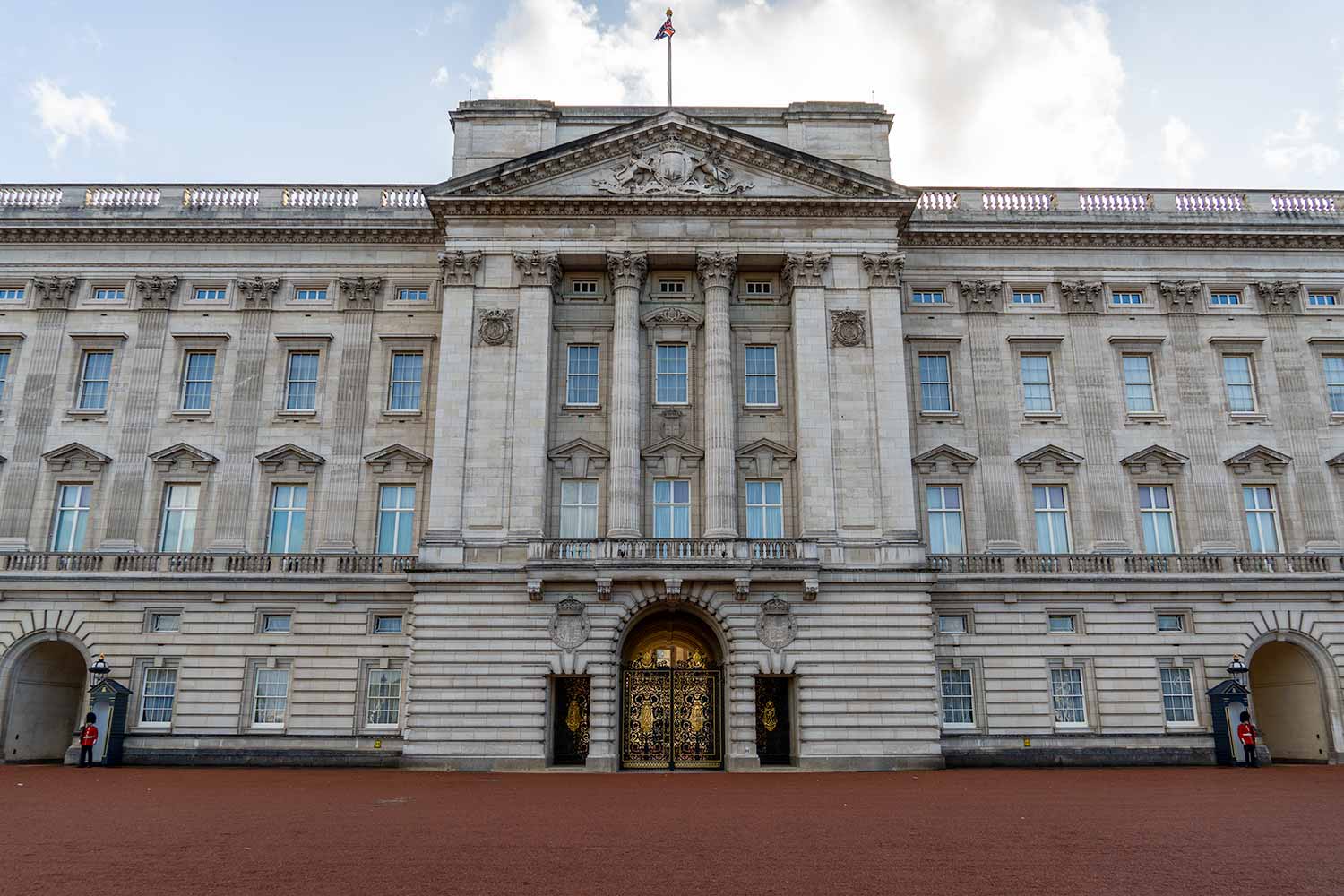 Buckingham Palace: Also located in the City of Westminster is Buckingham Palace—the residence and headquarters of the United Kingdom’s monarchy. Monumentally important to the British people, the palace is a focal point for celebration, mourning, and general festivities.
Buckingham Palace: Also located in the City of Westminster is Buckingham Palace—the residence and headquarters of the United Kingdom’s monarchy. Monumentally important to the British people, the palace is a focal point for celebration, mourning, and general festivities.
The Victoria Memorial—a monument dedicated to Queen Victoria—stands in front of the palace.
Cost: You can find more information and buy tickets on the official Buckingham Palace website. Tickets are cheaper for students, and children under 5 are granted free entry. Recommended Duration of Visit: 15 minutes – 2 hours (if you decide to tour the palace).
| Booking tickets in advance really helps, especially when you purchase the discounted London Pass. When booking online, you can choose a date and entry time. Even if you do not wish to book online, I recommend checking the website because you will be notified if certain days are closed, partly closed, or only open to services. Tickets purchased online are non-refundable and sent via email. Tickets allow entry for two hours. |
| The States Room is open to visitors on select dates during the Summers and Springs. Refer to the official website for more details on opening dates and hours. If you elect to treat your purchase as a donation, then the ticket essentially becomes a 1-Year Pass (still subjected to official opening dates and times). You must get the ticket stamped in order for it to become a 1-Year Pass. The 1-Year Pass is non-transferrable. |
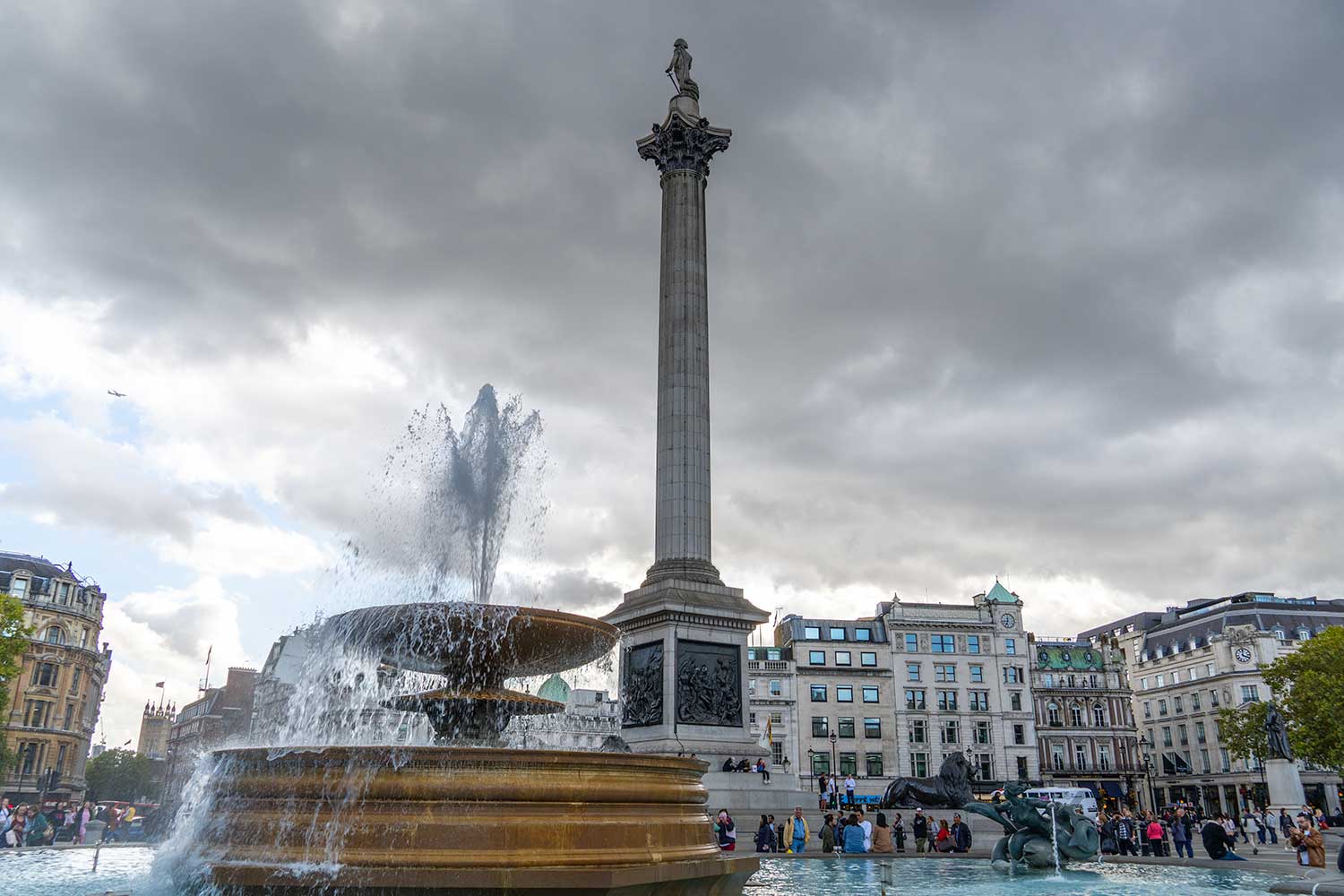 Trafalgar Square: This public square, located in central London (still within the City of Westminster), is one of the main hubs of activity and community events in London. Morever, the square is near many shops, restaurants, statues, fountains, and displays, among others.
Trafalgar Square: This public square, located in central London (still within the City of Westminster), is one of the main hubs of activity and community events in London. Morever, the square is near many shops, restaurants, statues, fountains, and displays, among others.
The name commemorates the Battle of Trafalgar—the British victory over the French and Spanish navies during the Napoleonic Wars.
Cost: Free to visit. Recommended Duration of Visit: 30 – 60 minutes.
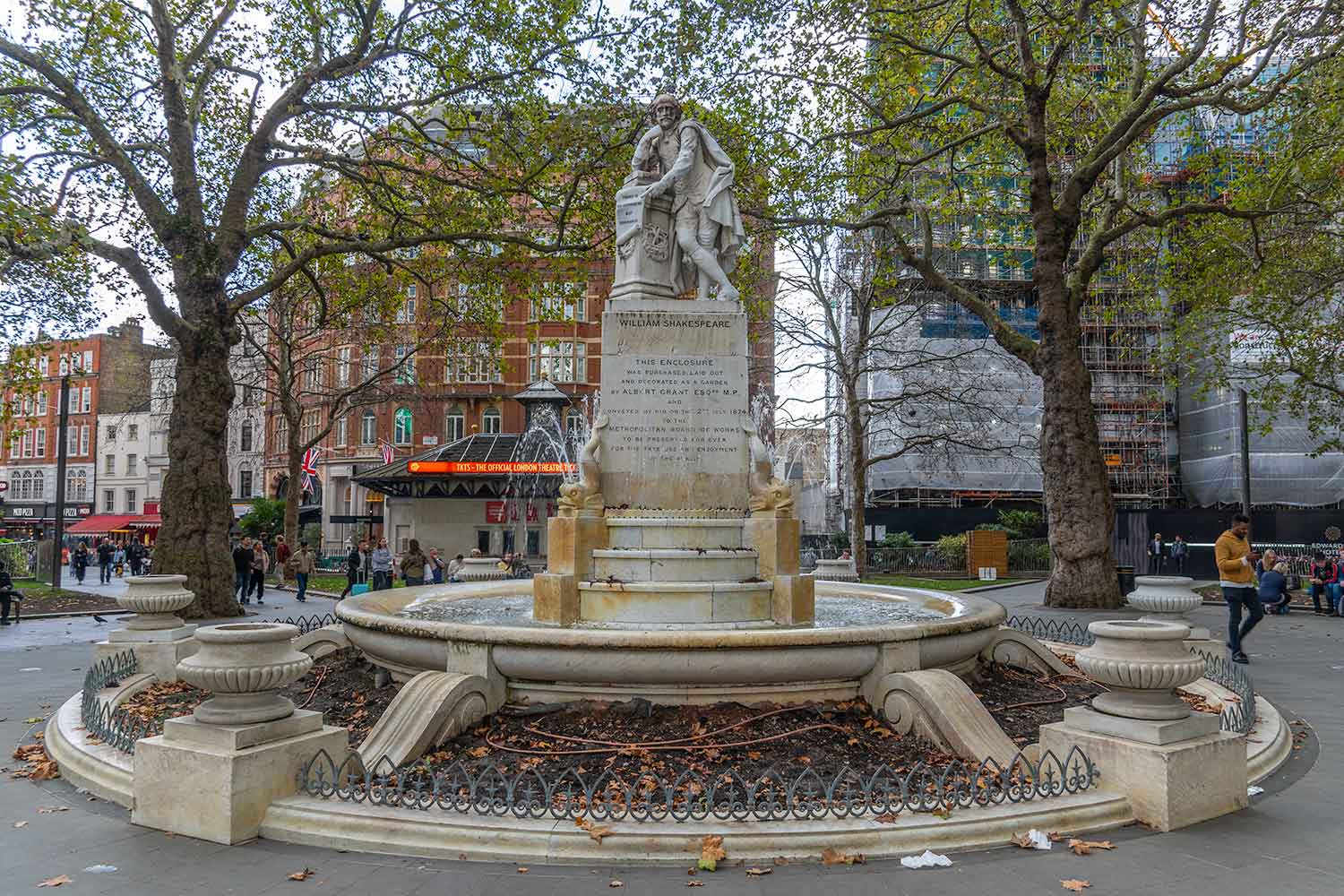 Leicester Square: This public square, named after the Earl of Leicester, is a major cinema and theater center. Beautiful architecture surrounds the square from all sides, and the atmosphere is always festive and fun.
Leicester Square: This public square, named after the Earl of Leicester, is a major cinema and theater center. Beautiful architecture surrounds the square from all sides, and the atmosphere is always festive and fun.
In addition to the small park and a very cool Lego store, there are many shops, restaurants, bars, street performers, and casinos, among others. The square—easily recognized via the William Shakespeare fountain—is also right next to Chinatown.
Cost: Free to visit. Recommended Duration of Visit: 30 – 60 minutes.
| Many talented artists, musicians, and general street performers can be found in this area. The National Gallery is also right next to the square. The Guards Crimean War Memorial is nearby as well. It is illegal to feed pigeons in Trafalgar Square. |
| Leicester Square is part of London’s “Theaterland.” The area contains many of London’s theaters and is the United Kingdom’s alternative to New York’s Broadway. If you are interested in seeing a theater show, then this area is a great place to start. |
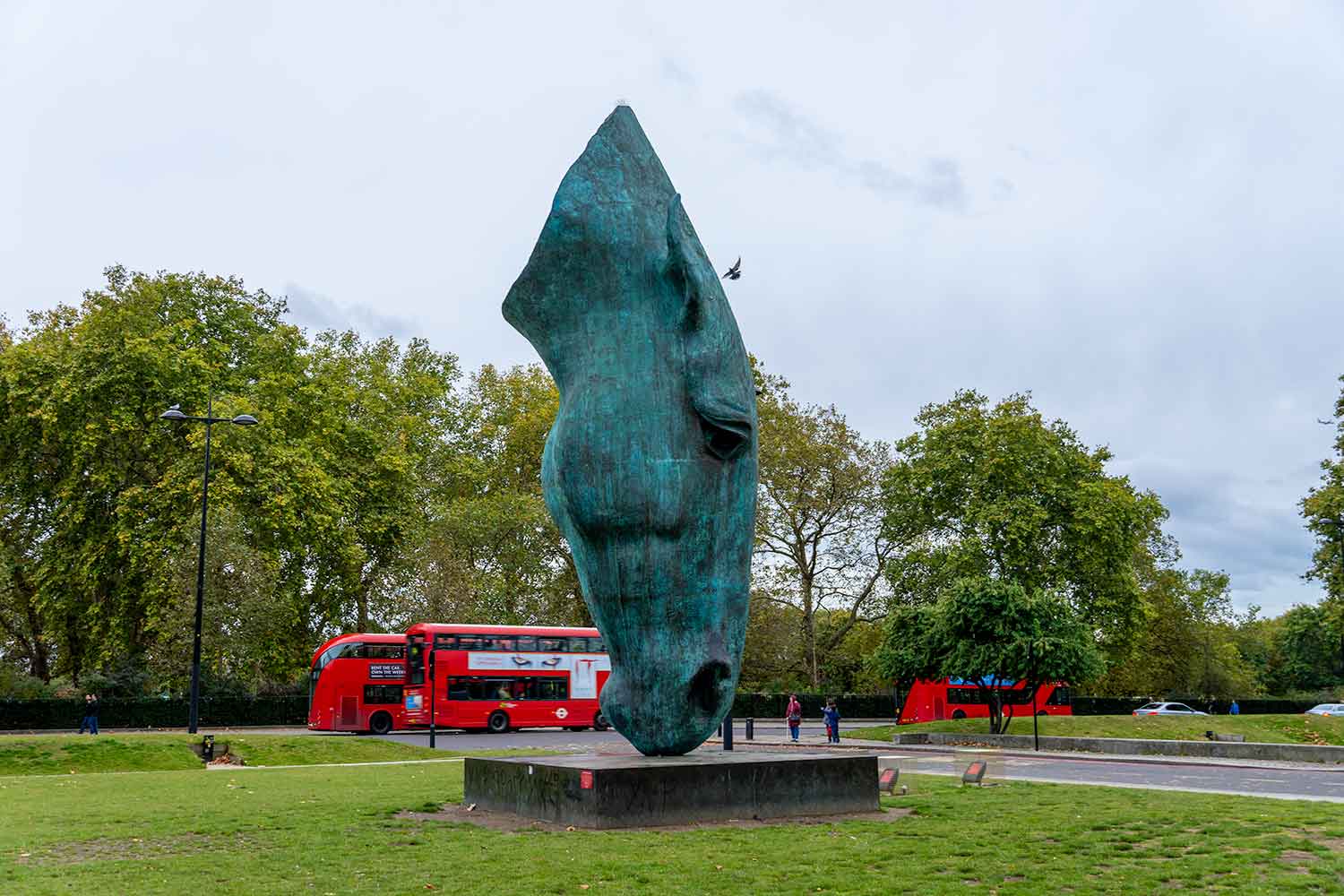 Hyde Park: As the largest Royal Park in London, this picturesque park contains a lake, a pond, numerous memorials, gardens, and even a palace. Major events are often held in this park throughout the year as well. For example, Hyde Park’s Winter Wonderland—one of Europe’s largest Christmas events—features Christmas-themed markets alongside various attractions, bars, and restaurants.
Hyde Park: As the largest Royal Park in London, this picturesque park contains a lake, a pond, numerous memorials, gardens, and even a palace. Major events are often held in this park throughout the year as well. For example, Hyde Park’s Winter Wonderland—one of Europe’s largest Christmas events—features Christmas-themed markets alongside various attractions, bars, and restaurants.
Cost: Free to visit. Recommended Duration of Visit: 1 – 2 hours.
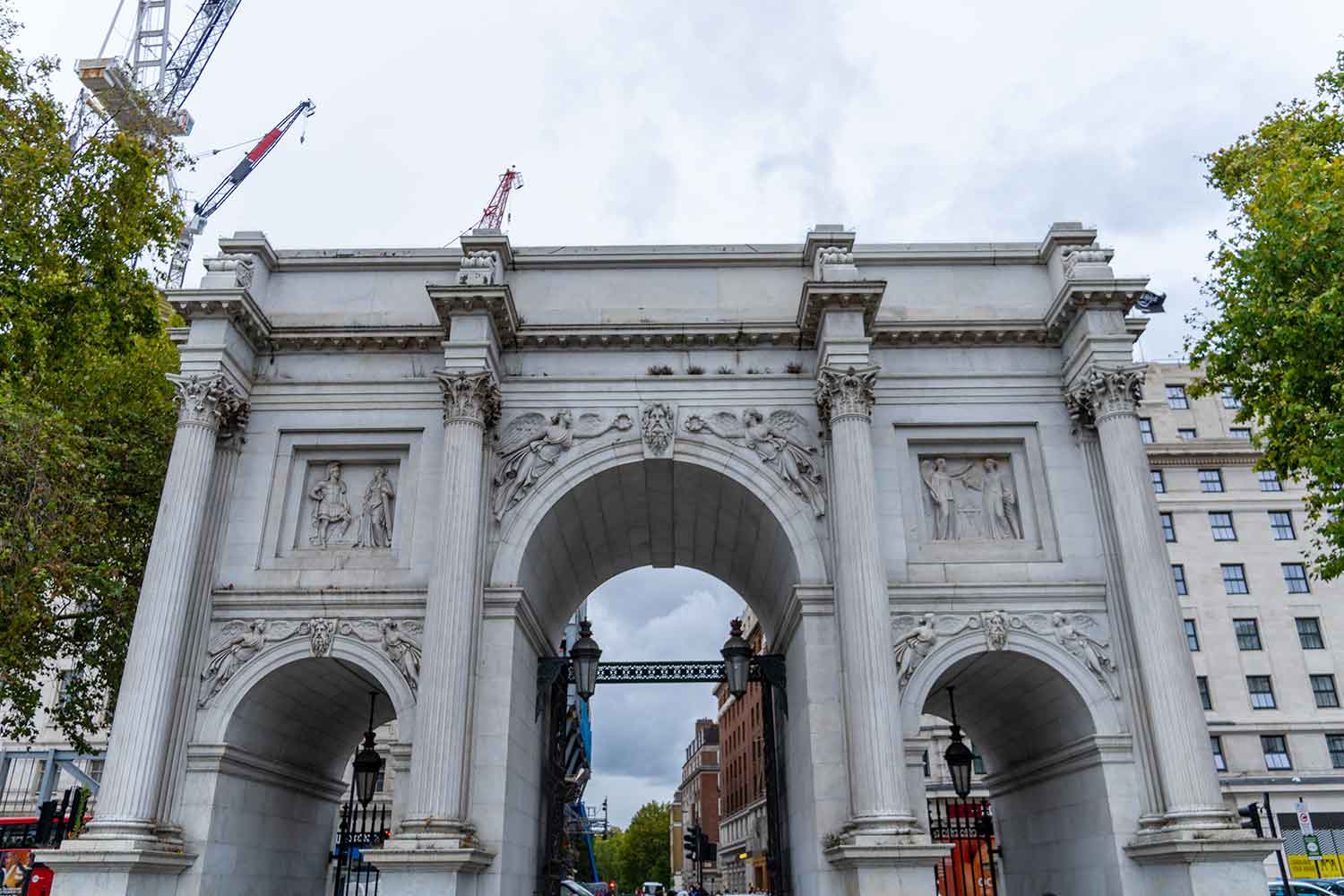 Marble Arch: This white marble triumphal arch was originally part of Buckingham palace until it was moved to Hyde Park. The Marble Arch and the Wellington Arch commemorate Britain’s victories in the Napoleonic Wars. Not much besides that. It looks cool.
Marble Arch: This white marble triumphal arch was originally part of Buckingham palace until it was moved to Hyde Park. The Marble Arch and the Wellington Arch commemorate Britain’s victories in the Napoleonic Wars. Not much besides that. It looks cool.
Cost: Free to visit. Recommended Duration of Visit: 5 – 10 minutes.
| Kensington Palace is toward the left side of Hyde Park. The Princess Diana Memorial Fountain and the gardens are toward the center of the park. |
| The Wellington Arch (the one with the statue on top) is on the bottom right corner of the park, and the Marble Arch is on the top right corner. |
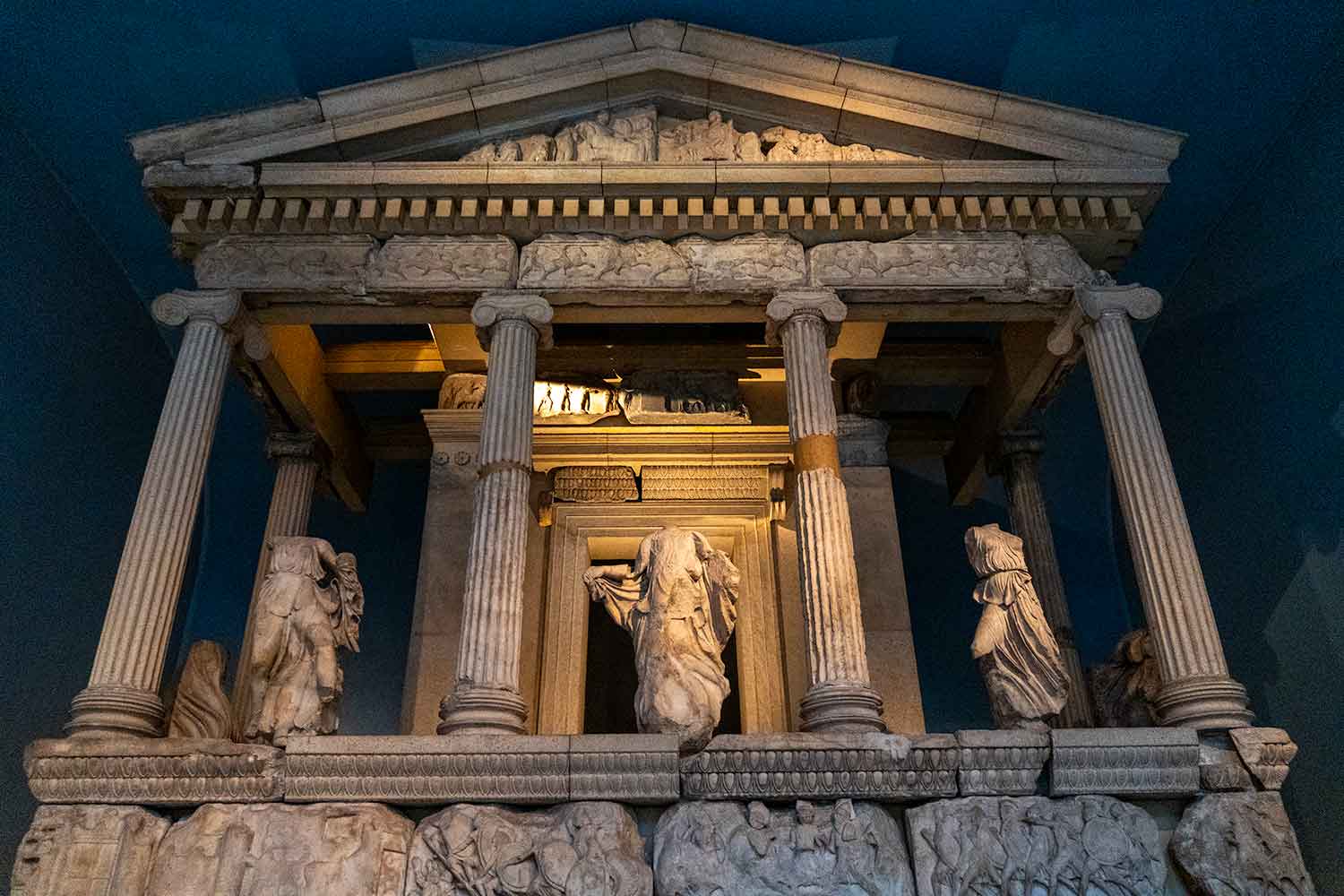 British Museum: The British Museum—the world’s first national public museum—focuses on human history, culture, and art. As one of the largest and most famous museums in the world, it features over 8 million objects.
British Museum: The British Museum—the world’s first national public museum—focuses on human history, culture, and art. As one of the largest and most famous museums in the world, it features over 8 million objects.
Many of the exhibits are nothing short phenomenal, with items from Mayan, Egyptian, Roman, Chinese, Japanese, Korean, European, and African cultures, among others. In addition to various incredibly rare artifacts, the museum also displays the legendary Rosetta Stone and a 5500-year-old mummy. Overall, this museum was wonderful from beginning to end.
Cost: Free to visit, but donations are appreciated. Recommended Duration of Visit: 3 – 6 hours.
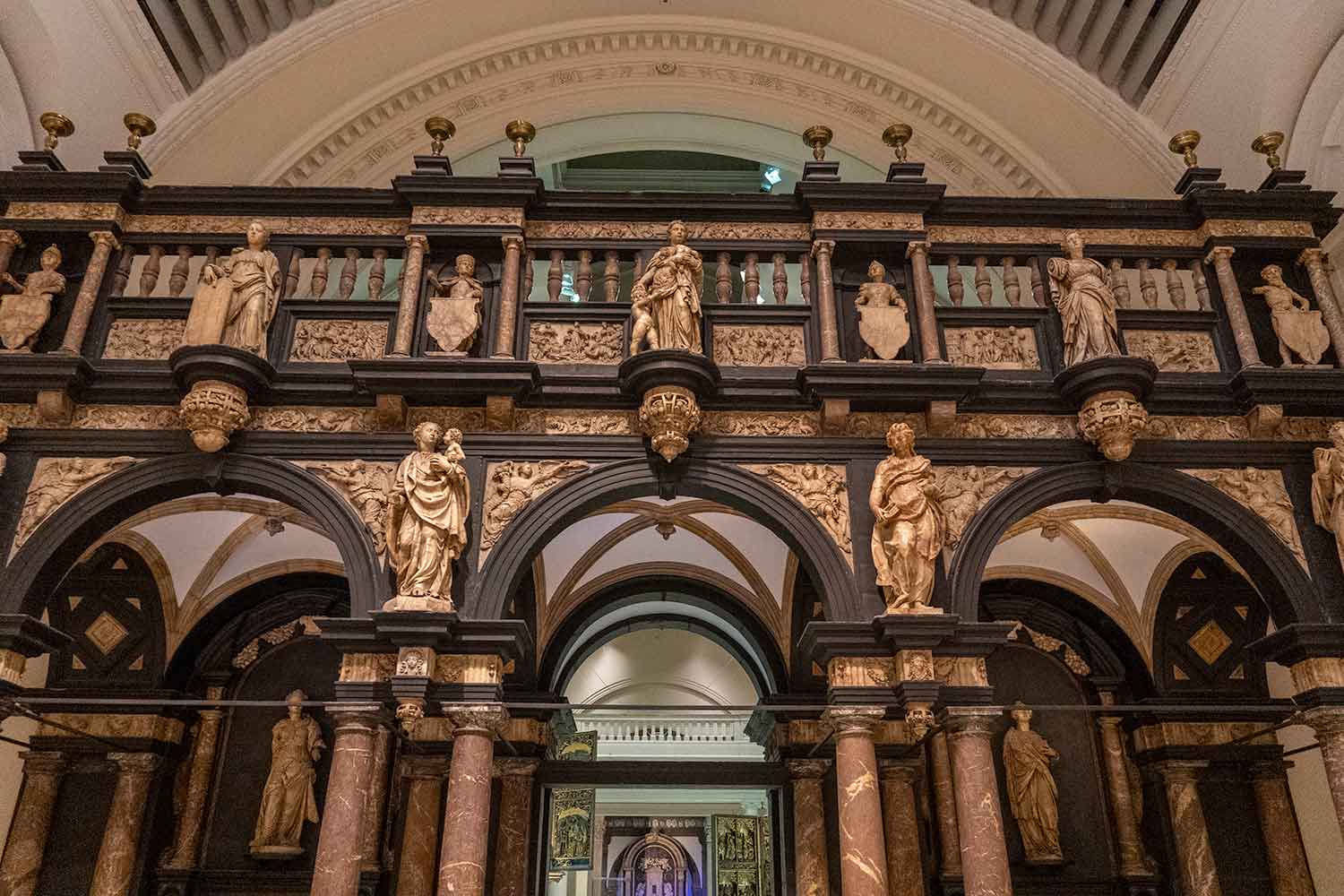 Victoria and Albert Museum: The Victoria and Albert Museum—the world’s largest museum of applied and decorative art and design—is named after Queen Victoria and Prince Albert.
Victoria and Albert Museum: The Victoria and Albert Museum—the world’s largest museum of applied and decorative art and design—is named after Queen Victoria and Prince Albert.
As one of the largest museums in the world in general, it contains over 2 million objects and has the largest collection of post-classical sculptures. Overall, its exhibits include art pieces from Classical, Chinese, Japanese, Korea, and Islamic cultures, among others.
Cost: Free to visit, but donations are appreciated. Recommended Duration of Visit: 2 – 3 hours.
| The museum is quite far from other more centralized attractions, so it should be among the first or last attractions of the day. |
| There are numerous entrances to the museum. One of the entrances is underground. |
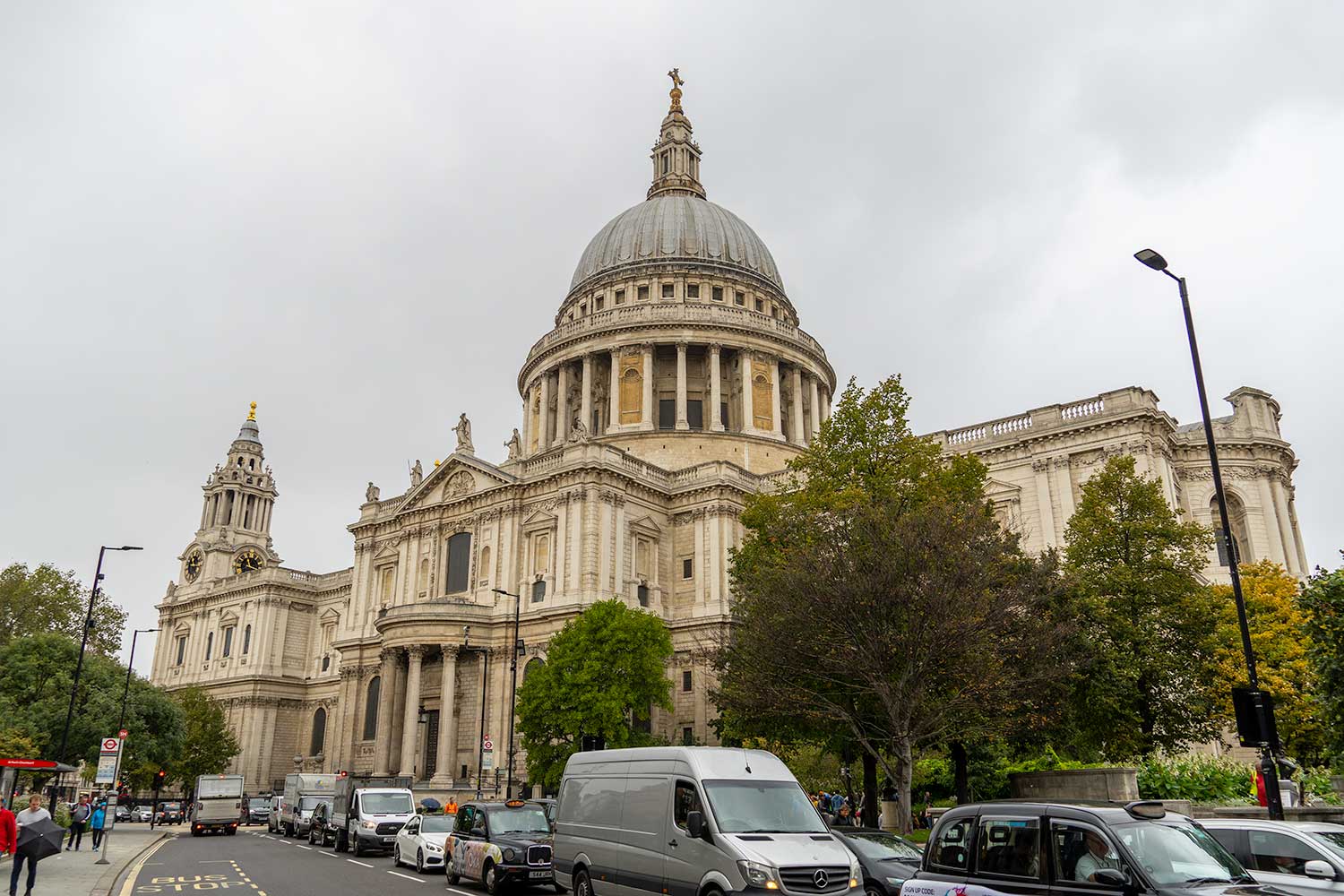 St. Paul’s Cathedral: St Paul’s Cathedral, standing at 365 feet (111 meters), is one of the most recognizable sites in London. The interior of this massive Anglican cathedral is striking, leaving one in awe of its unique architectural design and sheer vastness.
St. Paul’s Cathedral: St Paul’s Cathedral, standing at 365 feet (111 meters), is one of the most recognizable sites in London. The interior of this massive Anglican cathedral is striking, leaving one in awe of its unique architectural design and sheer vastness.
The cathedral also features a rich history, numerous elaborate statues, ornate displays, and a crypt, among others. As a bonus, there is an observation deck that offers a breathtaking panoramic view of London’s skyline. If you refer to my St. Paul’s Cathedral Guide, then you will see how truly amazing this place is.
Cost: You can find more information and buy tickets on the official St. Paul’s Cathedral website. Recommended Duration of Visit: 2 – 3 hours.
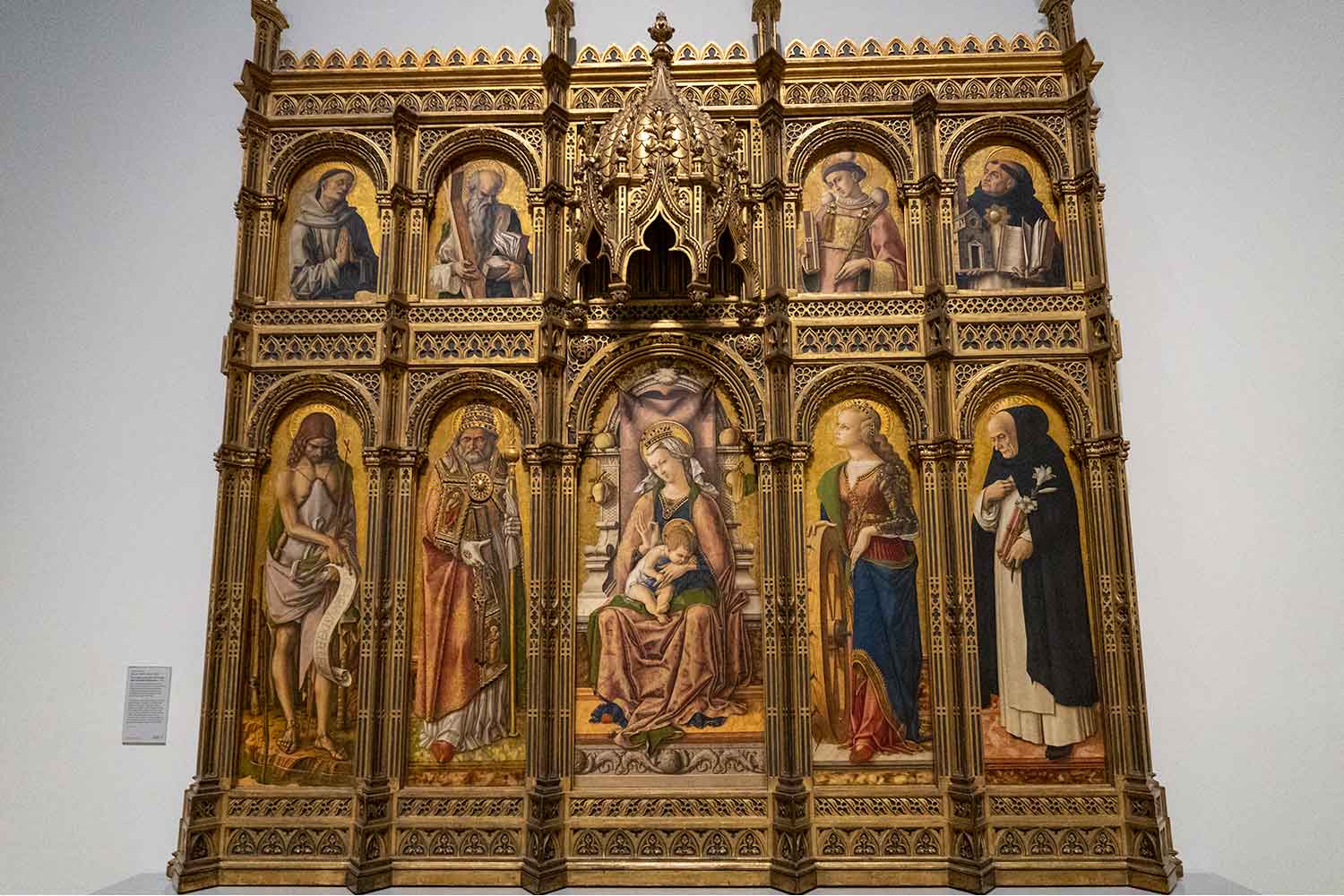 National Gallery: This art museum, located between Trafalgar and Leicester Square, houses over 2300 paintings—some of them dating back to the mid-13th century. Due to its exquisite collection, it is one of the most visited museums in the world.
National Gallery: This art museum, located between Trafalgar and Leicester Square, houses over 2300 paintings—some of them dating back to the mid-13th century. Due to its exquisite collection, it is one of the most visited museums in the world.
Cost: Free to visit, but donations are appreciated. Recommended Duration of Visit: 2 – 3 hours.
| It takes about 528 steps to reach the observation deck. Fair warning: the climb is quite difficult. |
| Since the National Gallery is so close to Trafalgar and Leicester square, it becomes quite crowded around noon and evening. |
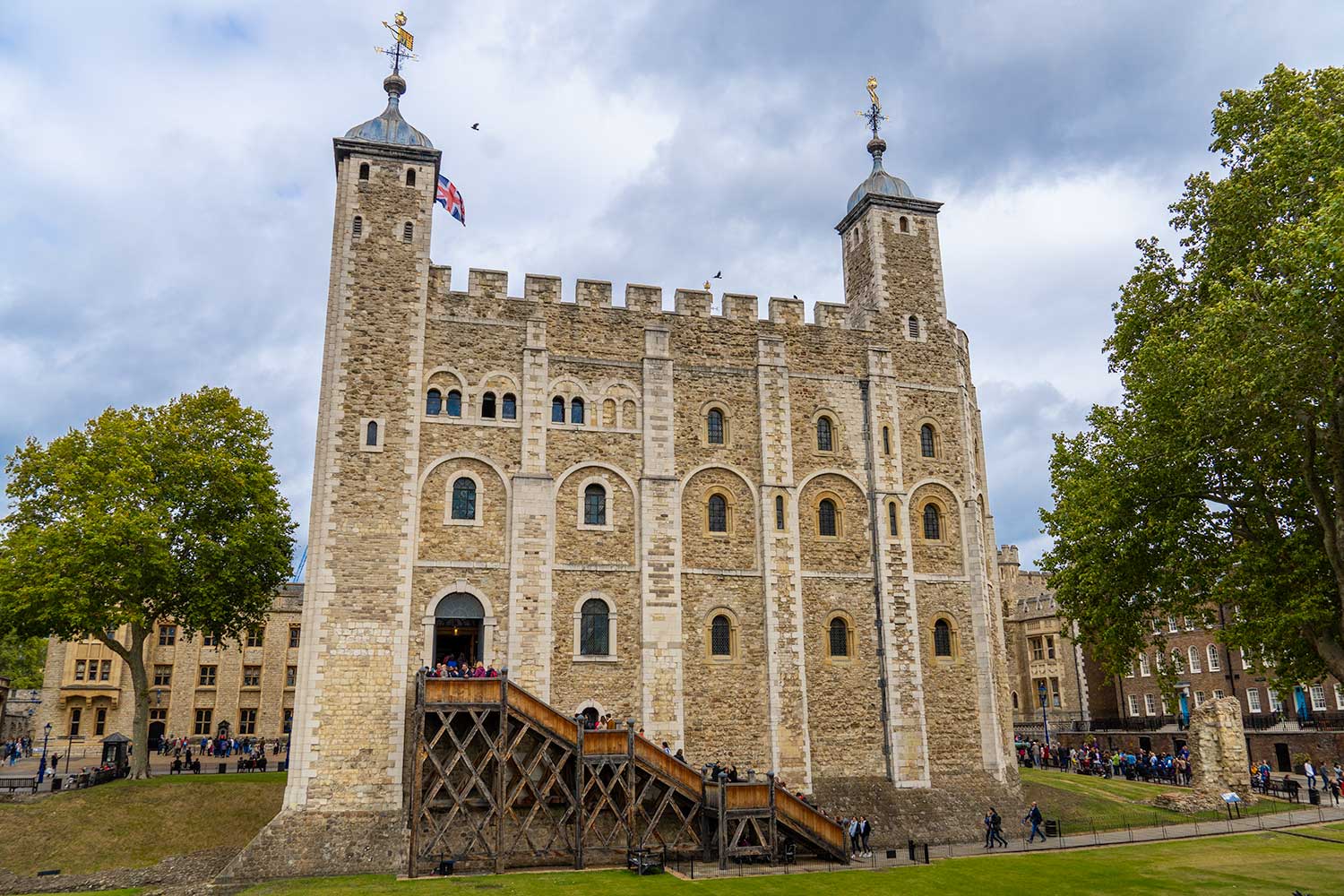 Tower of London: The Tower of London is less like a tower and more like a castle—complete with walls, several small towers, an armory, a menagerie (now replaced with displays instead), and a dungeon, among others.
Tower of London: The Tower of London is less like a tower and more like a castle—complete with walls, several small towers, an armory, a menagerie (now replaced with displays instead), and a dungeon, among others.
The White Tower, the central building that gave the entire castle its name, was built by William the Conqueror in 1078. The Crown Jewels are held in a separate building nearby. Since controlling the tower was important to many rulers, the tower was besieged numerous times throughout history.
There is also a superstition that, unless six ravens are present at all times, the kingdom will fall. Each raven has a wing clipped, and there are spare ravens handy just in case. If you refer to my Tower of London Guide, then you will see how truly amazing this place is.
Cost: You can find more information and buy tickets on the official Tower of London website. Recommended Duration of Visit: 3 – 6 hours.
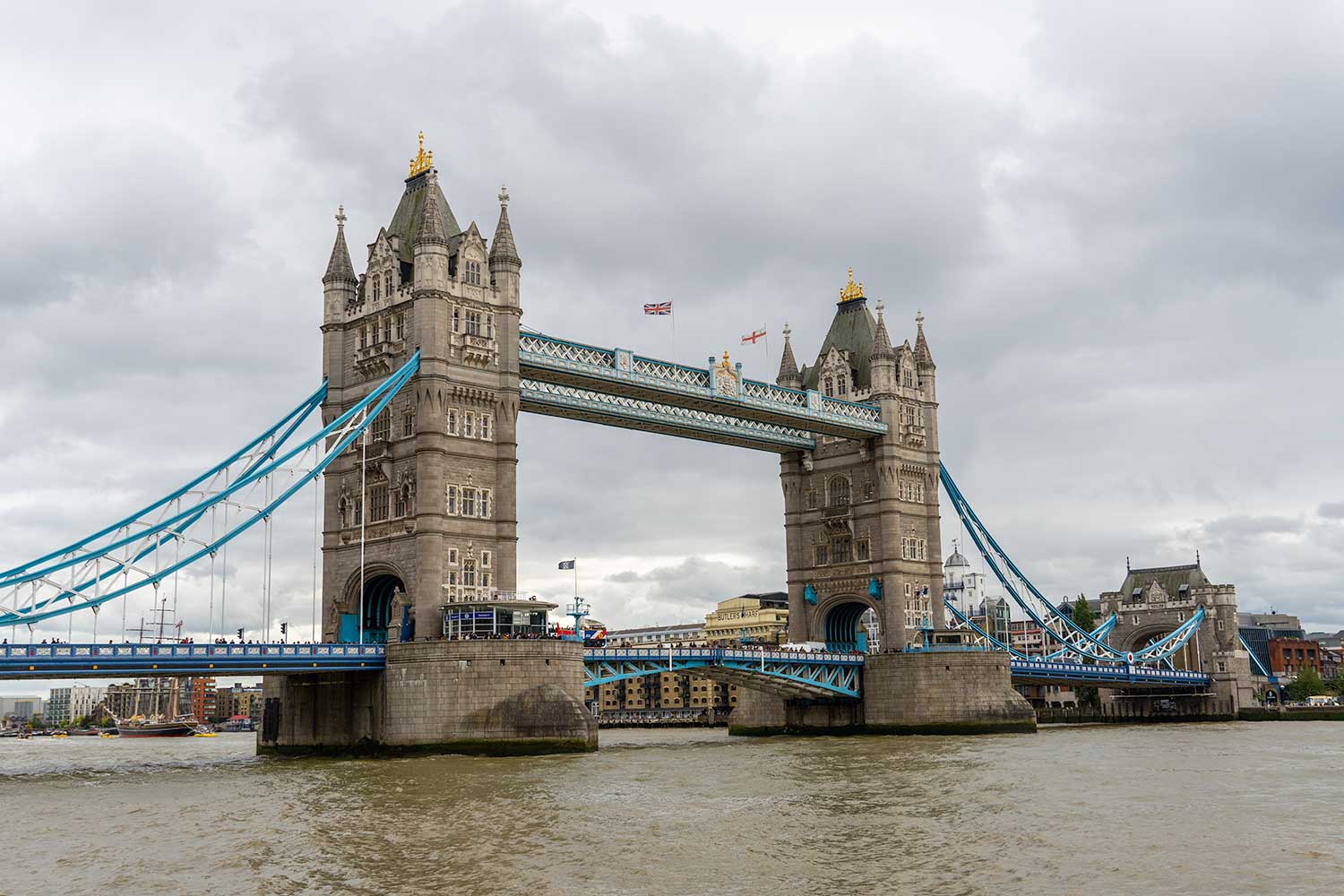 Tower Bridge: This bascule and suspension bridge, built between 1886 and 1894, is an iconic London landmark. At 801 feet (244 meters) long and 213 feet (65 meters) tall, it was built to ease road access while maintaining river access.
Tower Bridge: This bascule and suspension bridge, built between 1886 and 1894, is an iconic London landmark. At 801 feet (244 meters) long and 213 feet (65 meters) tall, it was built to ease road access while maintaining river access.
To this day, the Tower Bridge is still considered an engineering marvel. Visitors can cross over the bridge for an incredible view of the River Thames, and the elevated walkway allows visitors to experience the glass floors and panoramic views. The bridge closest to the Tower Bridge is the London Bridge.
Cost: The lower level is free to visit, but the elevated walkway has an admission charge. You can find more information and buy tickets on the official Tower Bridge website. Recommended Duration of Visit: 1 – 2 hours.
| There are many parts to the castle (Tower Green, Lanthorn Tower, Salt Tower, and the Crown Jewels exhibit, among others). The line to see the Crown Jewels is long (lasting over an hour sometimes), so make sure to plan ahead if you wish to see them. |
| The quickest way to reach the bridge is to take the London Underground to Tower Hill, conveniently located nearby. The Tower Bridge is within viewing distance of the Tower of London, so you can take some of the best photos from the tower walls. |
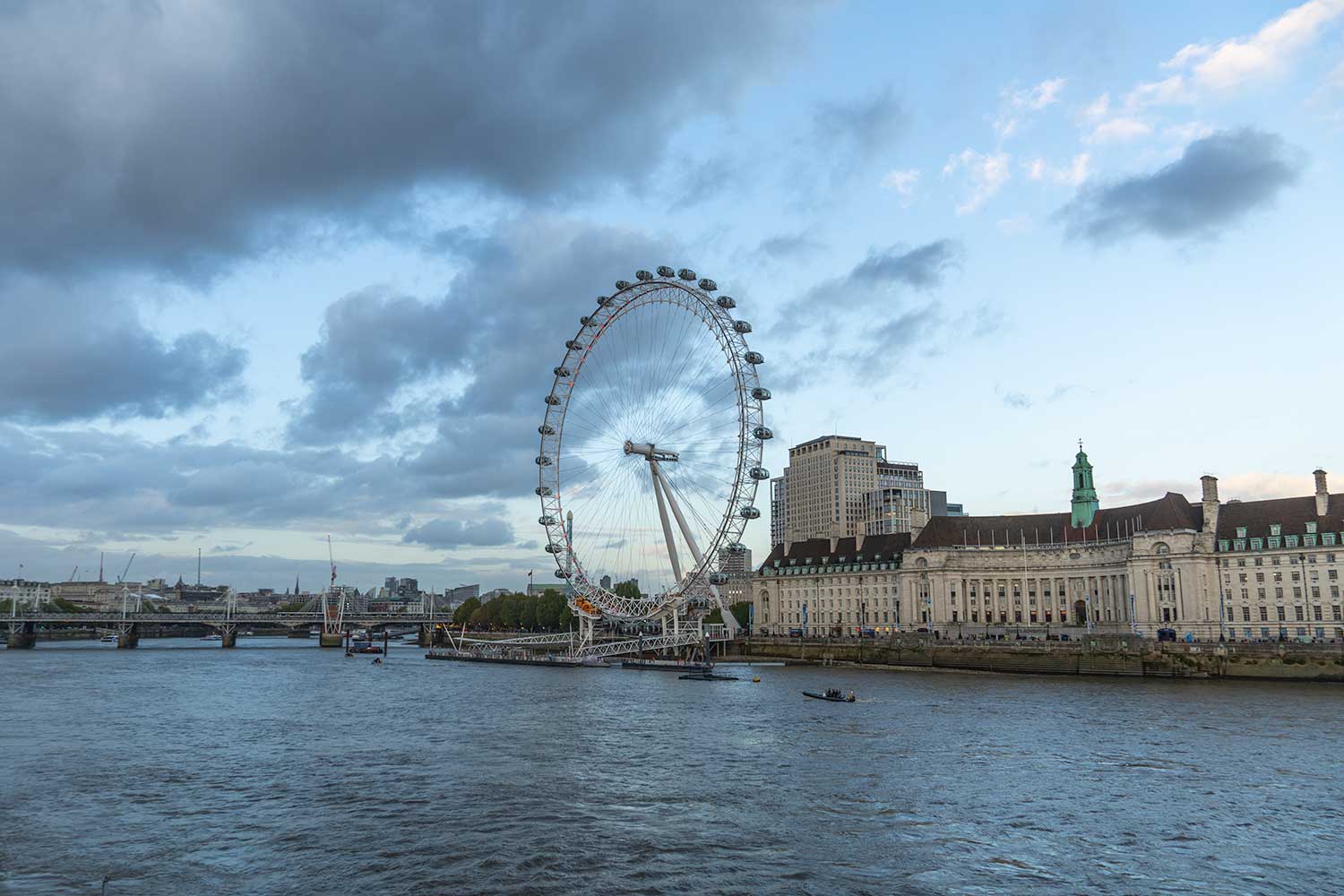 London Eye: This 443-feet (135-meter) tall Ferris Wheel, located at the Southbank of the River Thames, is Europe’s tallest Ferris Wheel. It is one of the most popular attractions for locals and tourists alike because it offers the second highest viewpoint of London.
London Eye: This 443-feet (135-meter) tall Ferris Wheel, located at the Southbank of the River Thames, is Europe’s tallest Ferris Wheel. It is one of the most popular attractions for locals and tourists alike because it offers the second highest viewpoint of London.
The Eye’s location is also quite excellent—right alongside the river, near a nice park (Jubilee Gardens) and aquarium (SEA LIFE Centre London Aquarium). One rotation takes about 25 – 30 minutes.
Cost: You can find more information and buy tickets on the official London Eye website. Recommended Duration of Visit: 25 – 30 minutes (if you are up there for much longer, then you are probably screwed).
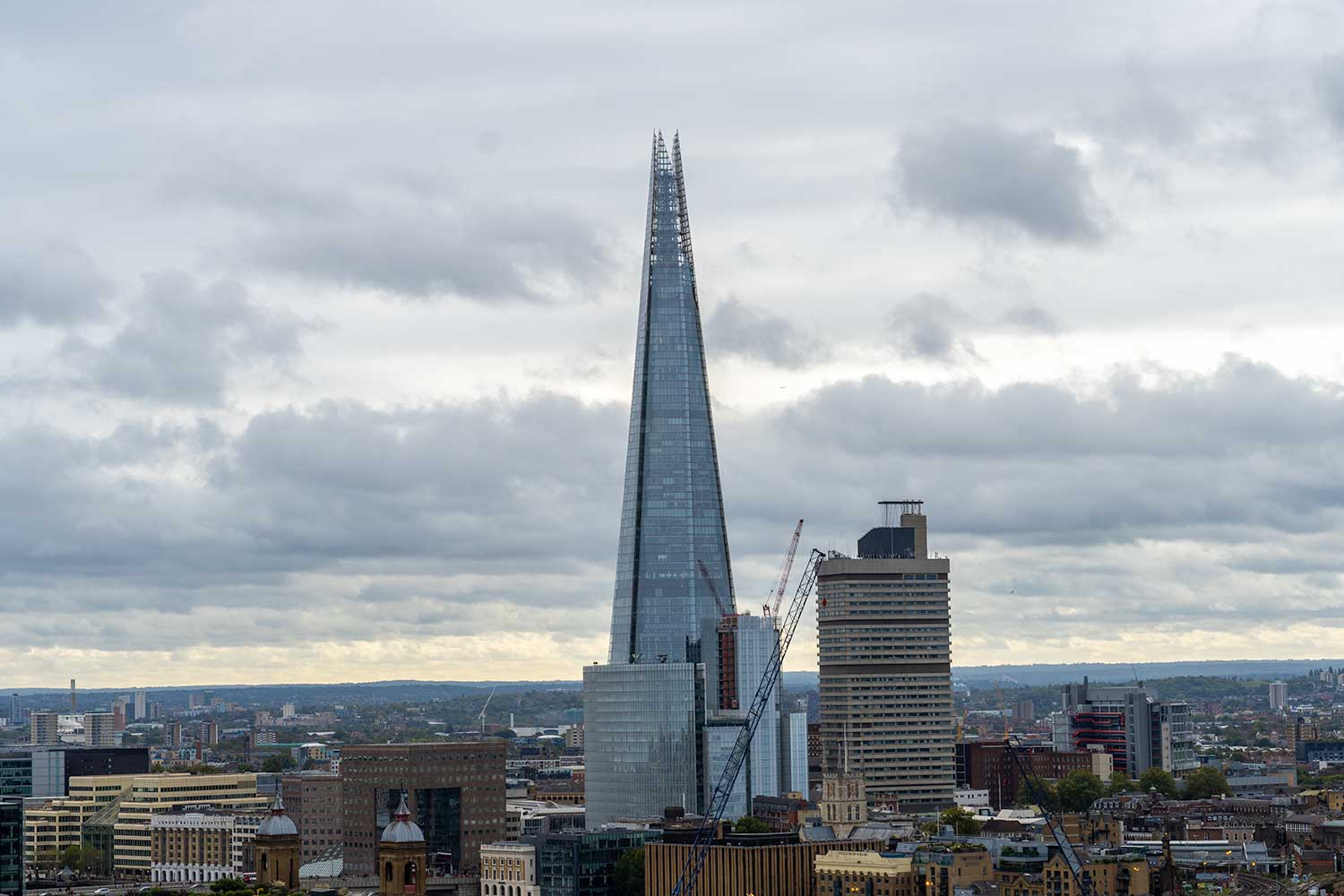 The Shard: The Shard, also known as the The Shard of Glass, is a 95-storey skyscraper. With the exception of telecommunications towers, it is the tallest structure in the United Kingdom. At 1016 feet (310 meters) tall, it offers the highest viewpoint of London—by far.
The Shard: The Shard, also known as the The Shard of Glass, is a 95-storey skyscraper. With the exception of telecommunications towers, it is the tallest structure in the United Kingdom. At 1016 feet (310 meters) tall, it offers the highest viewpoint of London—by far.
Cost: You can find more information and buy tickets on the official Shard website. Recommended Duration of Visit: 1 – 2 hours.
| Around sunset, the view is the most spectacular. I highly recommend checking the hours of operation on the website. On weekends, it is usually open until 8:30 pm. Although slightly more expensive, the Fast Track Ticket can save you hours waiting in line and allow you to time the sunset more effectively. |
| Like most skyscrapers, this one has protective glass surrounding the observation deck. Fortunately, St Paul’s Cathedral and the London Eye offer unobstructed views (and better photography opportunities). For planning purposes, the Tower of London and the Tower Bridge are on the other side of the River Thames. |
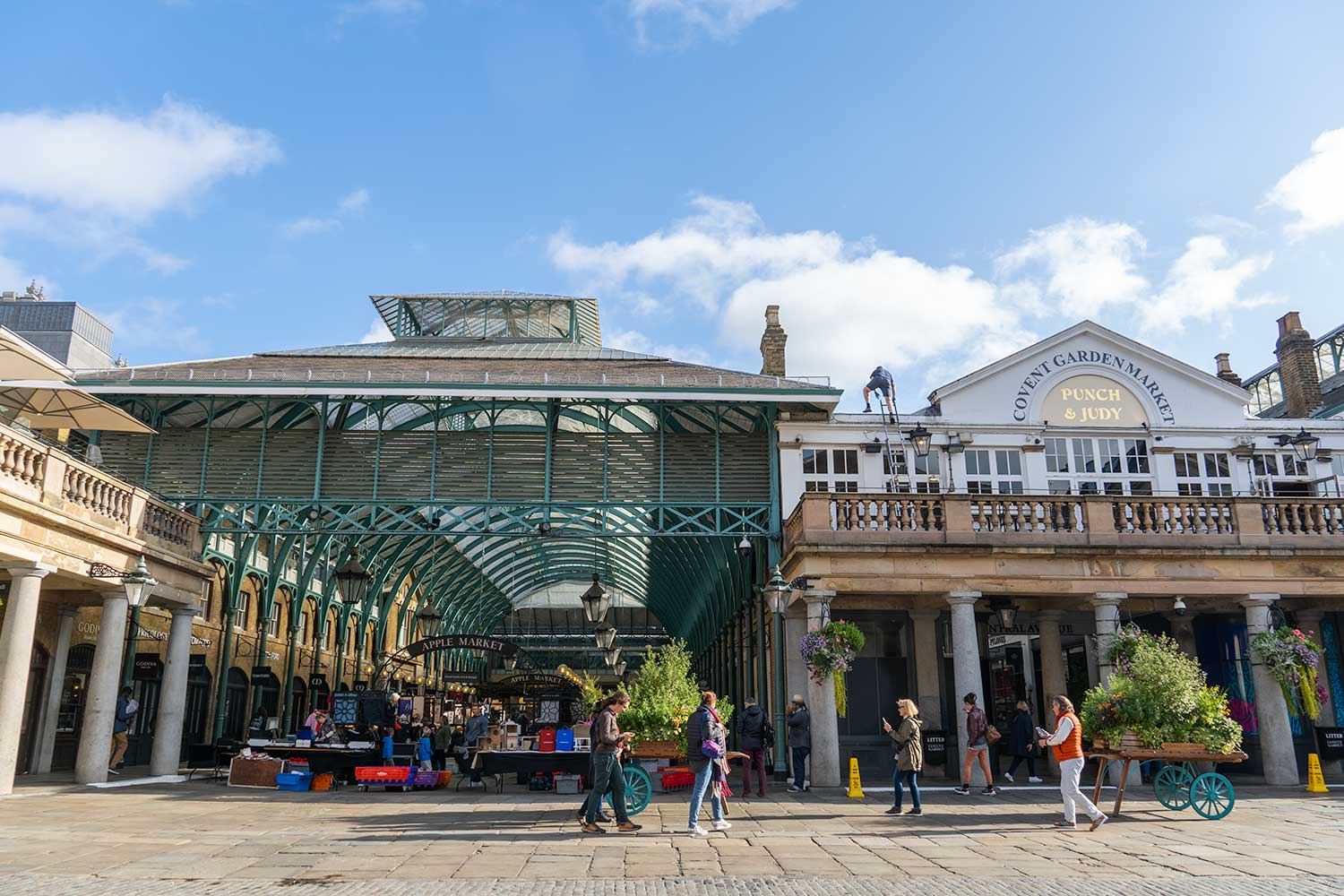 Covent Garden: Covent Garden is one of the major shopping, gastronomy, and entertainment hubs in London. This district has an open-air market, fashion stores, high-end restaurants, craft stalls, numerous theaters, and the Royal Opera House. The Covent Garden Piazza (i.e. central square) is also a major source of festivities and fun.
Covent Garden: Covent Garden is one of the major shopping, gastronomy, and entertainment hubs in London. This district has an open-air market, fashion stores, high-end restaurants, craft stalls, numerous theaters, and the Royal Opera House. The Covent Garden Piazza (i.e. central square) is also a major source of festivities and fun.
Cost: Variable depending on activity. Recommended Duration of Visit: 1 – 3 hours.
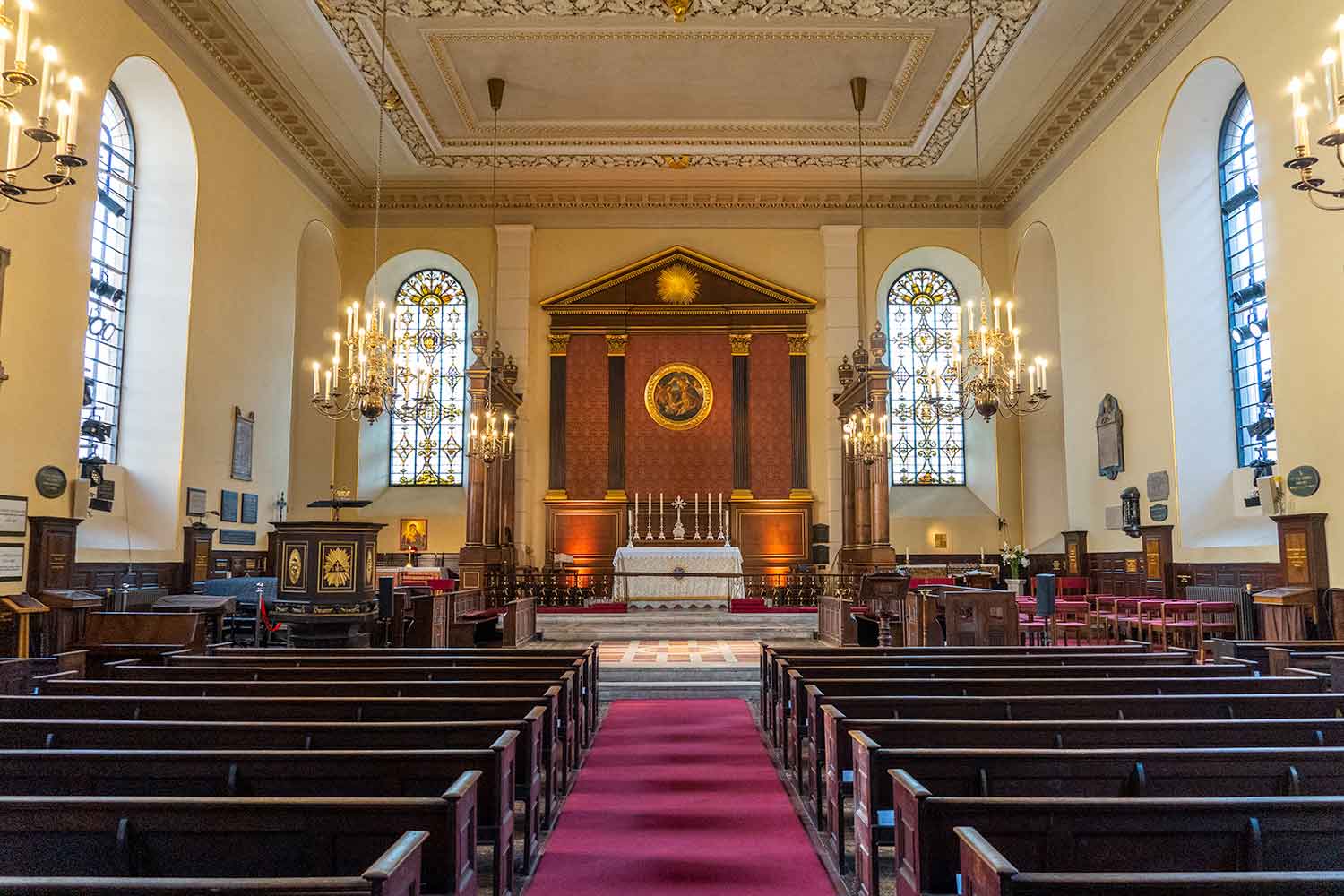 St. Paul’s Church: St. Paul’s Church, located within Covent Garden, is a hidden gem that memorializes many famous actors over the years. Due to its long association with the theater community, it is commonly known as The Actors’ Church. There are many wonderful entertainers in this area as well. Overall, it is a very nice place to visit for some peace and quiet.
St. Paul’s Church: St. Paul’s Church, located within Covent Garden, is a hidden gem that memorializes many famous actors over the years. Due to its long association with the theater community, it is commonly known as The Actors’ Church. There are many wonderful entertainers in this area as well. Overall, it is a very nice place to visit for some peace and quiet.
Cost: Free to visit. Recommended Duration of Visit: 15 – 30 minutes.
| Covent Garden is essentially a large region that lies to the right of Leicester Square. |
| There are five entrances to the church. I even took a nap, because no one was there. |
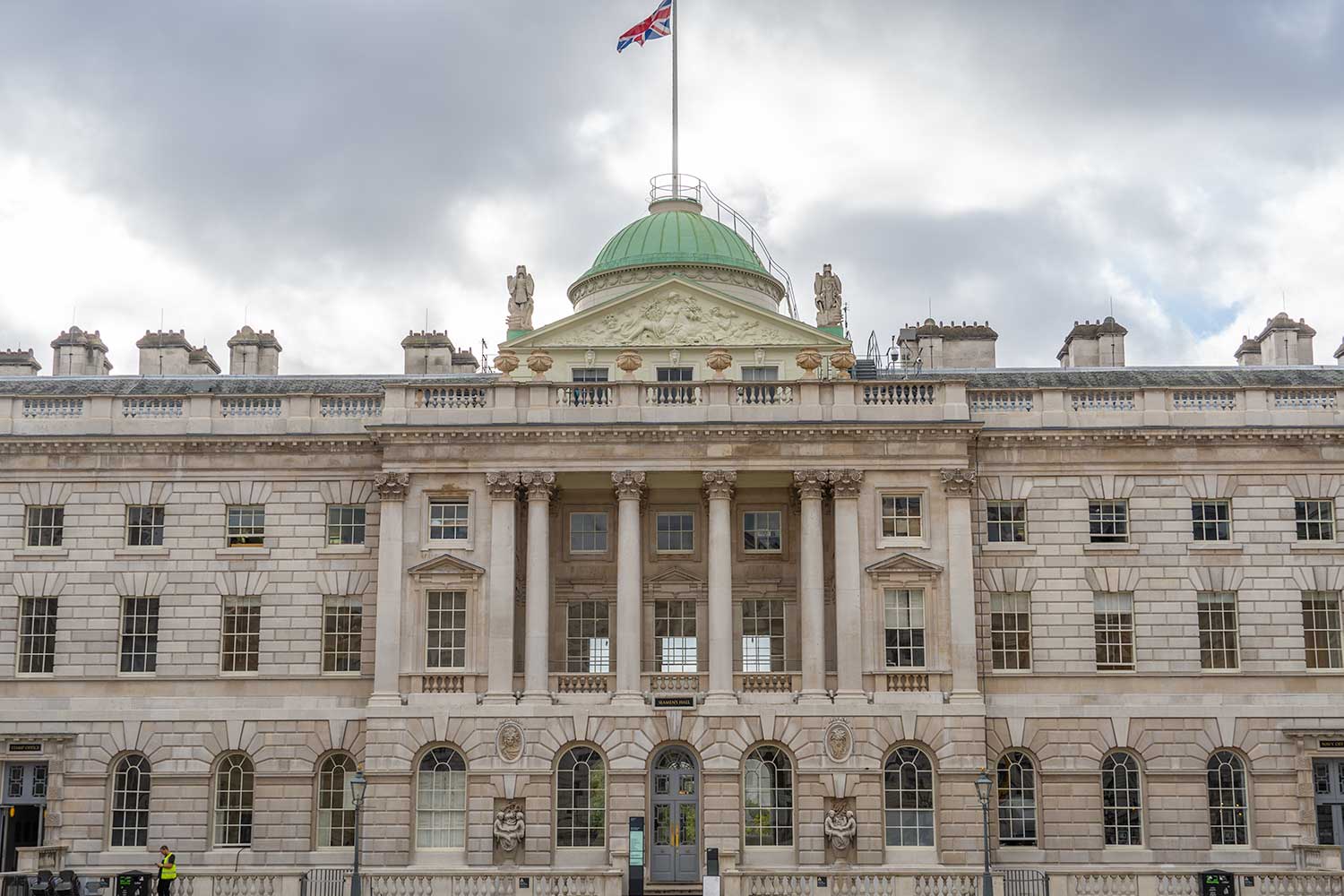 Somerset House: The Somerset House, located along the River Thames, features a rich history, elegant Neoclassical architecture, and a beautiful courtyard. On special holidays (i.e. Christmas and New Years), it will light up in a brilliant display of colors.
Somerset House: The Somerset House, located along the River Thames, features a rich history, elegant Neoclassical architecture, and a beautiful courtyard. On special holidays (i.e. Christmas and New Years), it will light up in a brilliant display of colors.
During the summer, numerous fountains offer some aquatic fun in the sun. During the winter, the Somerset House Ice Rink offers delightful fun alongside a festive and scenic atmosphere.
Cost: Free to visit, but you must purchase tickets for some exhibitions. You can find more information and buy tickets on the official Somerset House website. Recommended Duration of Visit: 1 – 2 hours.
 Royal Courts of Justice: This elegant representation of Gothic architecture contains the High Court and Court of Appeal. It is also one of the largest courts in Europe. Overall, this place just looks really cool.
Royal Courts of Justice: This elegant representation of Gothic architecture contains the High Court and Court of Appeal. It is also one of the largest courts in Europe. Overall, this place just looks really cool.
Cost: Free to Visit. The courts are generally open to the public, but there might be some restrictions depending on specific cases and circumstances. Recommended Duration of Visit: 30 – 60 minutes.
| For planning purposes, the Somerset House is on the way to the Royal Courts of Justice, St. Paul’s Cathedral, the Tower of London, and the Tower Bridge. |
| Photos are not allowed in certain areas. There is also a small museum inside. The Court is open until 4:30 pm on weekdays and is closed on weekends. |
With the exception of St. Paul’s Cathedral and the museums, the other attractions are paired up based on similarity and/or proximity. For example, The Tower of London and the Tower Bridge are near each other.
Most of the phenomenal museums in London are free to visit, but donations are appreciated. Additionally, most museums are open later on Fridays.
St. Paul’s Cathedral’s observation deck offers the most complete view of London’s skyline. The London Eye provides a more centralized view since it is pretty much toward the city center.
 Big Ben (Elizabeth Tower): Big Ben is a cultural icon recognized all over the world. Interestingly enough, Big Ben is actually the name of the Great Bell in the Elizabeth Tower. It is also the largest of the towers five bells. The Gothic Revival tower—one of the most prominent symbols of the United Kingdon—stands at 315 feet (96 meters) tall.
Big Ben (Elizabeth Tower): Big Ben is a cultural icon recognized all over the world. Interestingly enough, Big Ben is actually the name of the Great Bell in the Elizabeth Tower. It is also the largest of the towers five bells. The Gothic Revival tower—one of the most prominent symbols of the United Kingdon—stands at 315 feet (96 meters) tall.
Cost: Free to visit. Recommended Duration of Visit: 10 – 20 minutes.
| To be fair, most people will never get to see it like this, so it’s actually quite a rare site to see (crappy, but rare). |
| Little Ben stands at the interesection of Vauxhall Bridge Road and Victoria Street in Westminster. |
 Westminster Abbey: This Gothic church, founded in 960 AD and formally known as the Collegiate Church of Saint Peter at Westminster, lies in the City of Westminster (a borough within London).
Westminster Abbey: This Gothic church, founded in 960 AD and formally known as the Collegiate Church of Saint Peter at Westminster, lies in the City of Westminster (a borough within London).
As one of the United Kingdom’s most widely-recognized buildings, Westminster Abbey is a World Heritage Site, the final resting place of over a dozen monarchs, and a very popular must-see tourist attraction. Ever since William the Conqueror’s coronation (the first Norman King of England), all coronations of monarchs have been held here.
Cost: Visitors who attend for worship are allowed to do so for free. Otherwise, you can find more information and buy tickets on the official Westminster Abbey website. Tickets are cheaper for students. Recommended Duration of Visit: 10 minutes – 2 hours (if you want to explore inside).
| Booking tickets in advance really helps, especially when you purchase the discounted London Pass. When booking online, you can choose a date and entry time. Even if you do not wish to book online, I recommend checking the website because you will be notified if certain days are closed, partly closed, or only open to services. Tickets purchased online are non-refundable and sent via email. Tickets allow entry for two hours. |
 Buckingham Palace: Also located in the City of Westminster is Buckingham Palace—the residence and headquarters of the United Kingdom’s monarchy. Monumentally important to the British people, the palace is a focal point for celebration, mourning, and general festivities.
Buckingham Palace: Also located in the City of Westminster is Buckingham Palace—the residence and headquarters of the United Kingdom’s monarchy. Monumentally important to the British people, the palace is a focal point for celebration, mourning, and general festivities.
The Victoria Memorial—a monument dedicated to Queen Victoria—stands in front of the palace.
Cost: You can find more information and buy tickets on the official Buckingham Palace website. Tickets are cheaper for students, and children under 5 are granted free entry. Recommended Duration of Visit: 15 minutes – 2 hours (if you decide to tour the palace).
| The States Room is open to visitors on select dates during the Summers and Springs. Refer to the official website for more details on opening dates and hours. If you elect to treat your purchase as a donation, then the ticket essentially becomes a 1-Year Pass (still subjected to official opening dates and times). You must get the ticket stamped in order for it to become a 1-Year Pass. The 1-Year Pass is non-transferrable. |
 Trafalgar Square: This public square, located in central London (still within the City of Westminster), is one of the main hubs of activity and community events in London. Morever, the square is near many shops, restaurants, statues, fountains, and displays, among others.
Trafalgar Square: This public square, located in central London (still within the City of Westminster), is one of the main hubs of activity and community events in London. Morever, the square is near many shops, restaurants, statues, fountains, and displays, among others.
The name commemorates the Battle of Trafalgar—the British victory over the French and Spanish navies during the Napoleonic Wars.
Cost: Free to visit. Recommended Duration of Visit: 30 – 60 minutes.
| Many talented artists, musicians, and general street performers can be found in this area. The National Gallery is also right next to the square. The Guards Crimean War Memorial is nearby as well. It is illegal to feed pigeons in Trafalgar Square. |
 Leicester Square: This public square, named after the Earl of Leicester, is a major cinema and theater center. Beautiful architecture surrounds the square from all sides, and the atmosphere is always festive and fun.
Leicester Square: This public square, named after the Earl of Leicester, is a major cinema and theater center. Beautiful architecture surrounds the square from all sides, and the atmosphere is always festive and fun.
In addition to the small park and a very cool Lego store, there are many shops, restaurants, bars, street performers, and casinos, among others. The square—easily recognized via the William Shakespeare fountain—is also right next to Chinatown.
Cost: Free to visit. Recommended Duration of Visit: 30 – 60 minutes.
| Leicester Square is part of London’s “Theaterland.” The area contains many of London’s theaters and is the United Kingdom’s alternative to New York’s Broadway. If you are interested in seeing a theater show, then this area is a great place to start. |
 Hyde Park: As the largest Royal Park in London, this picturesque park contains a lake, a pond, numerous memorials, gardens, and even a palace. Major events are often held in this park throughout the year as well. For example, Hyde Park’s Winter Wonderland—one of Europe’s largest Christmas events—features Christmas-themed markets alongside various attractions, bars, and restaurants.
Hyde Park: As the largest Royal Park in London, this picturesque park contains a lake, a pond, numerous memorials, gardens, and even a palace. Major events are often held in this park throughout the year as well. For example, Hyde Park’s Winter Wonderland—one of Europe’s largest Christmas events—features Christmas-themed markets alongside various attractions, bars, and restaurants.
Cost: Free to visit. Recommended Duration of Visit: 1 – 2 hours.
| Kensington Palace is toward the left side of Hyde Park. The Princess Diana Memorial Fountain and the gardens are toward the center of the park. |
 Marble Arch: This white marble triumphal arch was originally part of Buckingham palace until it was moved to Hyde Park. The Marble Arch and the Wellington Arch commemorate Britain’s victories in the Napoleonic Wars. Not much besides that. It looks cool.
Marble Arch: This white marble triumphal arch was originally part of Buckingham palace until it was moved to Hyde Park. The Marble Arch and the Wellington Arch commemorate Britain’s victories in the Napoleonic Wars. Not much besides that. It looks cool.
Cost: Free to visit. Recommended Duration of Visit: 5 – 10 minutes.
| The Wellington Arch (the one with the statue on top) is on the bottom right corner of the park, and the Marble Arch is on the top right corner. |
 British Museum: The British Museum—the world’s first national public museum—focuses on human history, culture, and art. As one of the largest and most famous museums in the world, it features over 8 million objects.
British Museum: The British Museum—the world’s first national public museum—focuses on human history, culture, and art. As one of the largest and most famous museums in the world, it features over 8 million objects.
Many of the exhibits are nothing short phenomenal, with items from Mayan, Egyptian, Roman, Chinese, Japanese, Korean, European, and African cultures, among others. In addition to various incredibly rare artifacts, the museum also displays the legendary Rosetta Stone and a 5500-year-old mummy. Overall, this museum was wonderful from beginning to end.
Cost: Free to visit, but donations are appreciated. Recommended Duration of Visit: 3 – 6 hours.
| The museum is quite far from other more centralized attractions, so it should be among the first or last attractions of the day. |
 Victoria and Albert Museum: The Victoria and Albert Museum—the world’s largest museum of applied and decorative art and design—is named after Queen Victoria and Prince Albert.
Victoria and Albert Museum: The Victoria and Albert Museum—the world’s largest museum of applied and decorative art and design—is named after Queen Victoria and Prince Albert.
As one of the largest museums in the world in general, it contains over 2 million objects and has the largest collection of post-classical sculptures. Overall, its exhibits include art pieces from Classical, Chinese, Japanese, Korea, and Islamic cultures, among others.
Cost: Free to visit, but donations are appreciated. Recommended Duration of Visit: 2 – 3 hours.
| There are numerous entrances to the museum. One of the entrances is underground. |
 St. Paul’s Cathedral: St Paul’s Cathedral, standing at 365 feet (111 meters), is one of the most recognizable sites in London. The interior of this massive Anglican cathedral is striking, leaving one in awe of its unique architectural design and sheer vastness.
St. Paul’s Cathedral: St Paul’s Cathedral, standing at 365 feet (111 meters), is one of the most recognizable sites in London. The interior of this massive Anglican cathedral is striking, leaving one in awe of its unique architectural design and sheer vastness.
The cathedral also features a rich history, numerous elaborate statues, ornate displays, and a crypt, among others. As a bonus, there is an observation deck that offers a breathtaking panoramic view of London’s skyline. If you refer to my St. Paul’s Cathedral Guide, then you will see how truly amazing this place is.
Cost: You can find more information and buy tickets on the official St. Paul’s Cathedral website. Recommended Duration of Visit: 2 – 3 hours.
| It takes about 528 steps to reach the observation deck. Fair warning: the climb is quite difficult. |
 National Gallery: This art museum, located between Trafalgar and Leicester Square, houses over 2300 paintings—some of them dating back to the mid-13th century. Due to its exquisite collection, it is one of the most visited museums in the world.
National Gallery: This art museum, located between Trafalgar and Leicester Square, houses over 2300 paintings—some of them dating back to the mid-13th century. Due to its exquisite collection, it is one of the most visited museums in the world.
Cost: Free to visit, but donations are appreciated. Recommended Duration of Visit: 2 – 3 hours.
| Since the National Gallery is so close to Trafalgar and Leicester square, it becomes quite crowded around noon and evening. |
 Tower of London: The Tower of London is less like a tower and more like a castle—complete with walls, several small towers, an armory, a menagerie (now replaced with displays instead), and a dungeon, among others.
Tower of London: The Tower of London is less like a tower and more like a castle—complete with walls, several small towers, an armory, a menagerie (now replaced with displays instead), and a dungeon, among others.
The White Tower, the central building that gave the entire castle its name, was built by William the Conqueror in 1078. The Crown Jewels are held in a separate building nearby. Since controlling the tower was important to many rulers, the tower was besieged numerous times throughout history.
There is also a superstition that, unless six ravens are present at all times, the kingdom will fall. Each raven has a wing clipped, and there are spare ravens handy just in case. If you refer to my Tower of London Guide, then you will see how truly amazing this place is.
Cost: You can find more information and buy tickets on the official Tower of London website. Recommended Duration of Visit: 3 – 6 hours.
| There are many parts to the castle (Tower Green, Lanthorn Tower, Salt Tower, and the Crown Jewels exhibit, among others). The line to see the Crown Jewels is long (lasting over an hour sometimes), so make sure to plan ahead if you wish to see them. |
 Tower Bridge: This bascule and suspension bridge, built between 1886 and 1894, is an iconic London landmark. At 801 feet (244 meters) long and 213 feet (65 meters) tall, it was built to ease road access while maintaining river access.
Tower Bridge: This bascule and suspension bridge, built between 1886 and 1894, is an iconic London landmark. At 801 feet (244 meters) long and 213 feet (65 meters) tall, it was built to ease road access while maintaining river access.
To this day, the Tower Bridge is still considered an engineering marvel. Visitors can cross over the bridge for an incredible view of the River Thames, and the elevated walkway allows visitors to experience the glass floors and panoramic views. The bridge closest to the Tower Bridge is the London Bridge.
Cost: The lower level is free to visit, but the elevated walkway has an admission charge. You can find more information and buy tickets on the official Tower Bridge website. Recommended Duration of Visit: 1 – 2 hours.
| The quickest way to reach the bridge is to take the London Underground to Tower Hill, conveniently located nearby. The Tower Bridge is within viewing distance of the Tower of London, so you can take some of the best photos from the tower walls. |
 London Eye: This 443-feet (135-meter) tall Ferris Wheel, located at the Southbank of the River Thames, is Europe’s tallest Ferris Wheel. It is one of the most popular attractions for locals and tourists alike because it offers the second highest viewpoint of London.
London Eye: This 443-feet (135-meter) tall Ferris Wheel, located at the Southbank of the River Thames, is Europe’s tallest Ferris Wheel. It is one of the most popular attractions for locals and tourists alike because it offers the second highest viewpoint of London.
The Eye’s location is also quite excellent—right alongside the river, near a nice park (Jubilee Gardens) and aquarium (SEA LIFE Centre London Aquarium). One rotation takes about 25 – 30 minutes.
Cost: You can find more information and buy tickets on the official London Eye website. Recommended Duration of Visit: 25 – 30 minutes (if you are up there for much longer, then you are probably screwed).
| Around sunset, the view is the most spectacular. I highly recommend checking the hours of operation on the website. On weekends, it is usually open until 8:30 pm. Although slightly more expensive, the Fast Track Ticket can save you hours waiting in line and allow you to time the sunset more effectively. |
 The Shard: The Shard, also known as the The Shard of Glass, is a 95-storey skyscraper. With the exception of telecommunications towers, it is the tallest structure in the United Kingdom. At 1016 feet (310 meters) tall, it offers the highest viewpoint of London—by far.
The Shard: The Shard, also known as the The Shard of Glass, is a 95-storey skyscraper. With the exception of telecommunications towers, it is the tallest structure in the United Kingdom. At 1016 feet (310 meters) tall, it offers the highest viewpoint of London—by far.
Cost: You can find more information and buy tickets on the official Shard website. Recommended Duration of Visit: 1 – 2 hours.
| Like most skyscrapers, this one has protective glass surrounding the observation deck. Fortunately, St Paul’s Cathedral and the London Eye offer unobstructed views (and better photography opportunities). For planning purposes, the Tower of London and the Tower Bridge are on the other side of the River Thames. |
 Covent Garden: Covent Garden is one of the major shopping, gastronomy, and entertainment hubs in London. This district has an open-air market, fashion stores, high-end restaurants, craft stalls, numerous theaters, and the Royal Opera House. The Covent Garden Piazza (i.e. central square) is also a major source of festivities and fun.
Covent Garden: Covent Garden is one of the major shopping, gastronomy, and entertainment hubs in London. This district has an open-air market, fashion stores, high-end restaurants, craft stalls, numerous theaters, and the Royal Opera House. The Covent Garden Piazza (i.e. central square) is also a major source of festivities and fun.
Cost: Variable depending on activity. Recommended Duration of Visit: 1 – 3 hours.
| Covent Garden is essentially a large region that lies to the right of Leicester Square. |
 St. Paul’s Church: St. Paul’s Church, located within Covent Garden, is a hidden gem that memorializes many famous actors over the years. Due to its long association with the theater community, it is commonly known as The Actors’ Church. There are many wonderful entertainers in this area as well. Overall, it is a very nice place to visit for some peace and quiet.
St. Paul’s Church: St. Paul’s Church, located within Covent Garden, is a hidden gem that memorializes many famous actors over the years. Due to its long association with the theater community, it is commonly known as The Actors’ Church. There are many wonderful entertainers in this area as well. Overall, it is a very nice place to visit for some peace and quiet.
Cost: Free to visit. Recommended Duration of Visit: 15 – 30 minutes.
| There are five entrances to the church. I even took a nap, because no one was there. |
 Somerset House: The Somerset House, located along the River Thames, features a rich history, elegant Neoclassical architecture, and a beautiful courtyard. On special holidays (i.e. Christmas and New Years), it will light up in a brilliant display of colors.
Somerset House: The Somerset House, located along the River Thames, features a rich history, elegant Neoclassical architecture, and a beautiful courtyard. On special holidays (i.e. Christmas and New Years), it will light up in a brilliant display of colors.
During the summer, numerous fountains offer some aquatic fun in the sun. During the winter, the Somerset House Ice Rink offers delightful fun alongside a festive and scenic atmosphere.
Cost: Free to visit, but you must purchase tickets for some exhibitions. You can find more information and buy tickets on the official Somerset House website. Recommended Duration of Visit: 1 – 2 hours.
| For planning purposes, the Somerset House is on the way to the Royal Courts of Justice, St. Paul’s Cathedral, the Tower of London, and the Tower Bridge. |
 Royal Courts of Justice: This elegant representation of Gothic architecture contains the High Court and Court of Appeal. It is also one of the largest courts in Europe. Overall, this place just looks really cool.
Royal Courts of Justice: This elegant representation of Gothic architecture contains the High Court and Court of Appeal. It is also one of the largest courts in Europe. Overall, this place just looks really cool.
Cost: Free to Visit. The courts are generally open to the public, but there might be some restrictions depending on specific cases and circumstances. Recommended Duration of Visit: 30 – 60 minutes.
| Photos are not allowed in certain areas. There is also a small museum inside. The Court is open until 4:30 pm on weekdays and is closed on weekends. |
London’s Theaterland
London’s Theatreland–situated in a region known as West End (near Leicester Square)—features some of the best cinemas and theaters in the world. In fact, there are several dozen venues and some of the shows have been running for several decades. From Hamilton to Les Miserable to Harry Potter and the Cursed Child, there is a large and spectacular selection.
Whether you fancy a musical, a play, or simply a movie, London is one of the best places in the world to satisfy your needs. As previously mentioned, Theatreland is similar to New York’s Broadway.
More Information on Indian Accent
 The pumpkin and coconut soup and cheese and onion bread appetizers were simply sublime. They were honestly some of the most delicious appetizers I have ever had.
The pumpkin and coconut soup and cheese and onion bread appetizers were simply sublime. They were honestly some of the most delicious appetizers I have ever had.What to order: I recommend the Slow Cooked Lamb Barberry Pulao, Son-in-law Eggs. It’s slightly spicy and absolutely delicious. The appetizers are complementary.
More information on Moo Cantina Pub & Kitchen
What to order: The Ribeye is a great choice.
More information on Poppie’s Fish & Chips Soho
What to order: I recommend ordering the classic Fish and Chips. No need to get fancy.
More information on West Cornwall Pasty
What to order: The The Beef, Onion, and Potatoes Pasty is a classic. The Thai Panang Chicken was good as well.
More information on Gourmet Burger Kitchen
What to order: The Rocket Man was delicious. And although I did not have the opportunity to try it, the Lamburghini sounded pretty good (and funny) as well.
More Information on Indian Accent
 The pumpkin and coconut soup and cheese and onion bread appetizers were simply sublime. They were honestly some of the most delicious appetizers I have ever had.
The pumpkin and coconut soup and cheese and onion bread appetizers were simply sublime. They were honestly some of the most delicious appetizers I have ever had.What to order: I recommend the Slow Cooked Lamb Barberry Pulao, Son-in-law Eggs. It’s slightly spicy and absolutely delicious. The appetizers are complementary.
More information on Moo Cantina Pub & Kitchen
What to order: The Ribeye is a great choice.
More information on Poppie’s Fish & Chips Soho
What to order: I recommend ordering the classic Fish and Chips. No need to get fancy.
More information on West Cornwall Pasty
What to order: The The Beef, Onion, and Potatoes Pasty is a classic. The Thai Panang Chicken was good as well.
More information on Gourmet Burger Kitchen
What to order: The Rocket Man was delicious. And although I did not have the opportunity to try it, the Lamburghini sounded pretty good (and funny) as well.
The Soho area is generally good for people of all ages. More importantly, it’s near central London.
If you are around Covent Garden or any of the squares (i.e. Trafalgar and Leicester), there are plenty of pubs and bars as well. Sherlock Holmes and Duke of Wellington are very popular pubs.
The nightclubs are scattered all around Soho and Covent Garden as well. Luxx Club London, Rumba, Tiger Tiger, Tramp (yes it is really called Tramp), and Ku Bar (supposedly one of the best gay night clubs in London) are all within walking distance of each other.
Note that this list is nowhere near comprehensive, and the places listed are not recommendations. They are simply some of the numerous places that I have noticed or visited, so they are good starting points. I say head in their general direction and you will find many more on the way.
Although the weather can be quite gloomy at times, London is overwhelmingly a vibrant city—rich in history, full of attractions, and scenically diverse. It is no wonder that London is one of the most visited and globally important cities in the world. In my opinion, no European trip would be complete without visiting London.
On a final note, make sure to share this page so others will know more about London!
 © Copyright - Ace Adventurer
© Copyright - Ace Adventurer © Copyright - Ace AdventurerA Guide to St. Paul’s Cathedral: Things to See and Do
© Copyright - Ace AdventurerA Guide to St. Paul’s Cathedral: Things to See and Do